Allison Collection Photos
May, 1943
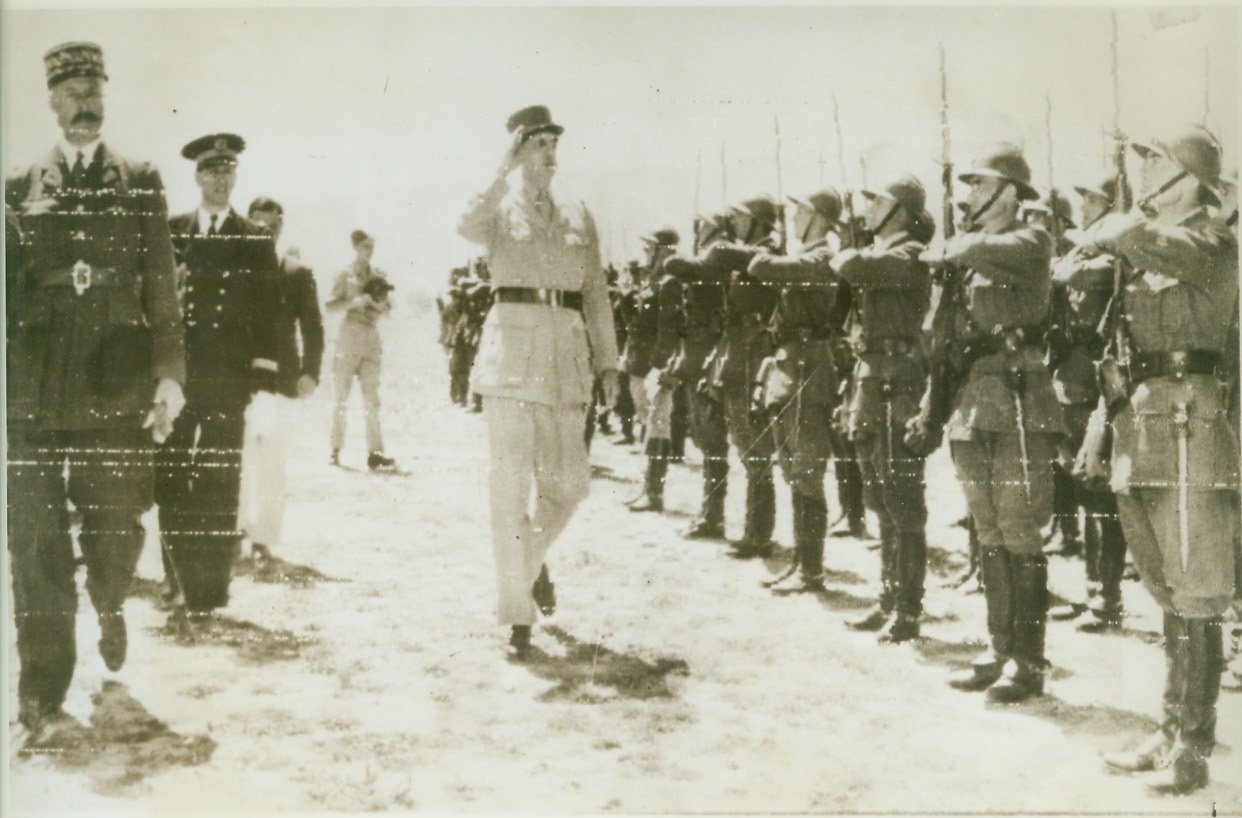
FIGHTING FRENCH HAIL DE GAULLE, 5/31/1943. ALGIERS, N. AFRICA – Just after his long awaited arrival in North Africa, General Charles De Gaulle (right) returns the salute of Fighting French soldiers as he leaves the airfield outside of Algiers with General Henri Giraud (left). Although Giraud made no announcement of the May 30th arrival of the Fighting French leader, Algerian crowds quickly discovered his presence and ignored bans on public demonstrations by shouting: “Vive De Gaulle.” Credit: OWI Radiophoto from ACME;
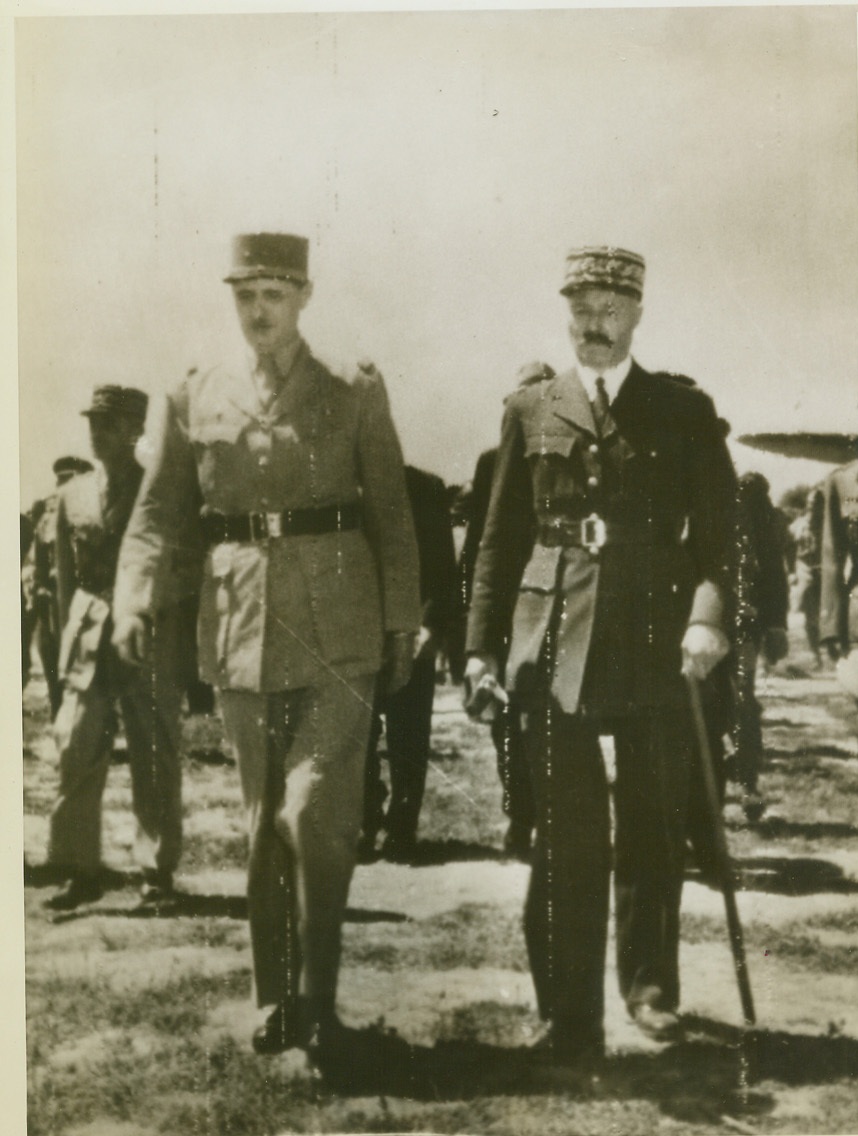
HERALDING FRENCH UNITY, 5/31/1943. ALGIERS – After an exchange of salutes and handshakes, General Charles De Gaulle (left) and General Henri Giraud leave the airport outside of Algiers where the Fighting French General landed May 30 for the long expected meeting. A very select committee greeted De Gaulle –Vichyites excluded. Although no public announcement of De Gaulle’s arrival was posted, the North African grapevine drew cheering crowds into the streets with cries of “Vive De Gaulle.” Credit: OWI Radiophoto from ACME;
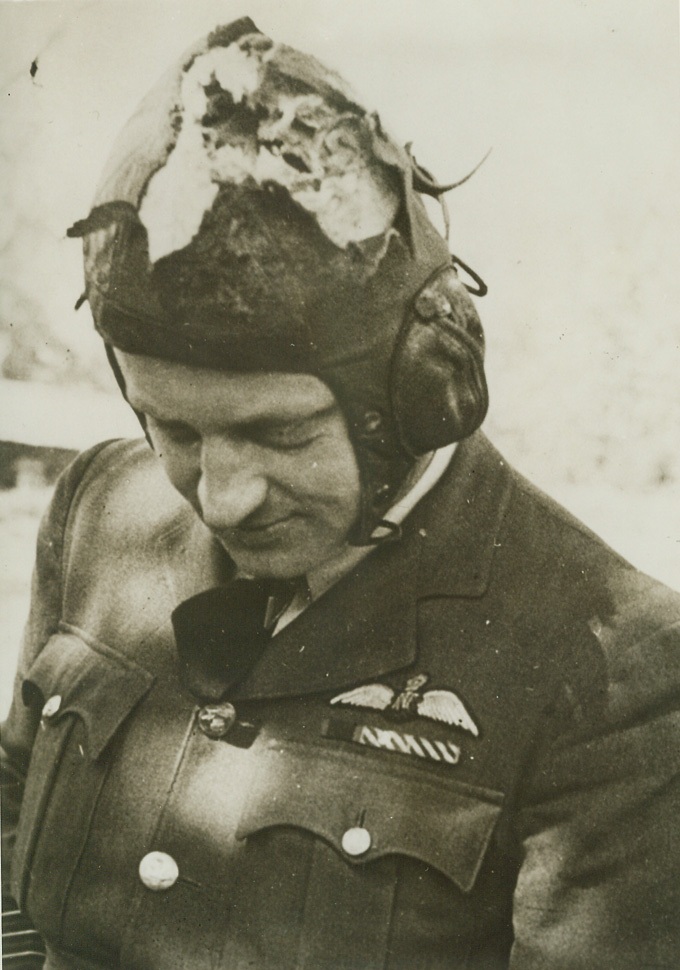
BETWEEN HIM AND DEATH, 5/23/1943. This shredded leather helmet is all that stood between Wing Commander Arthur Hay Donaldson and death when he led a flight of whirlwind fighters in a recent low-level attack on Morlaix airfield. Explosive shells from a ground battery reached his plane, and one went through his cockpit hood and tore through his helmet. Uninjured, the RAF man was knocked unconscious, but he soon recovered to keep his Whirlwind from crashing and fly back across 100 miles of channel to his base. Credit: ACME;

U.S.S. MARBLEHEAD RESCUES ARMY BOMBER CREW, 5/27/1943. Four members of an Army bomber crew who had been forced down at sea re picked up by a whaleboat from the U.S.S. Marblehead in a recent rescue by the famous Navy cruiser. The men spent five days on a rubber life raft in perilous seas without food and only eleven ounces of water.Credit: Off. U.S. Navy photo from Acme;
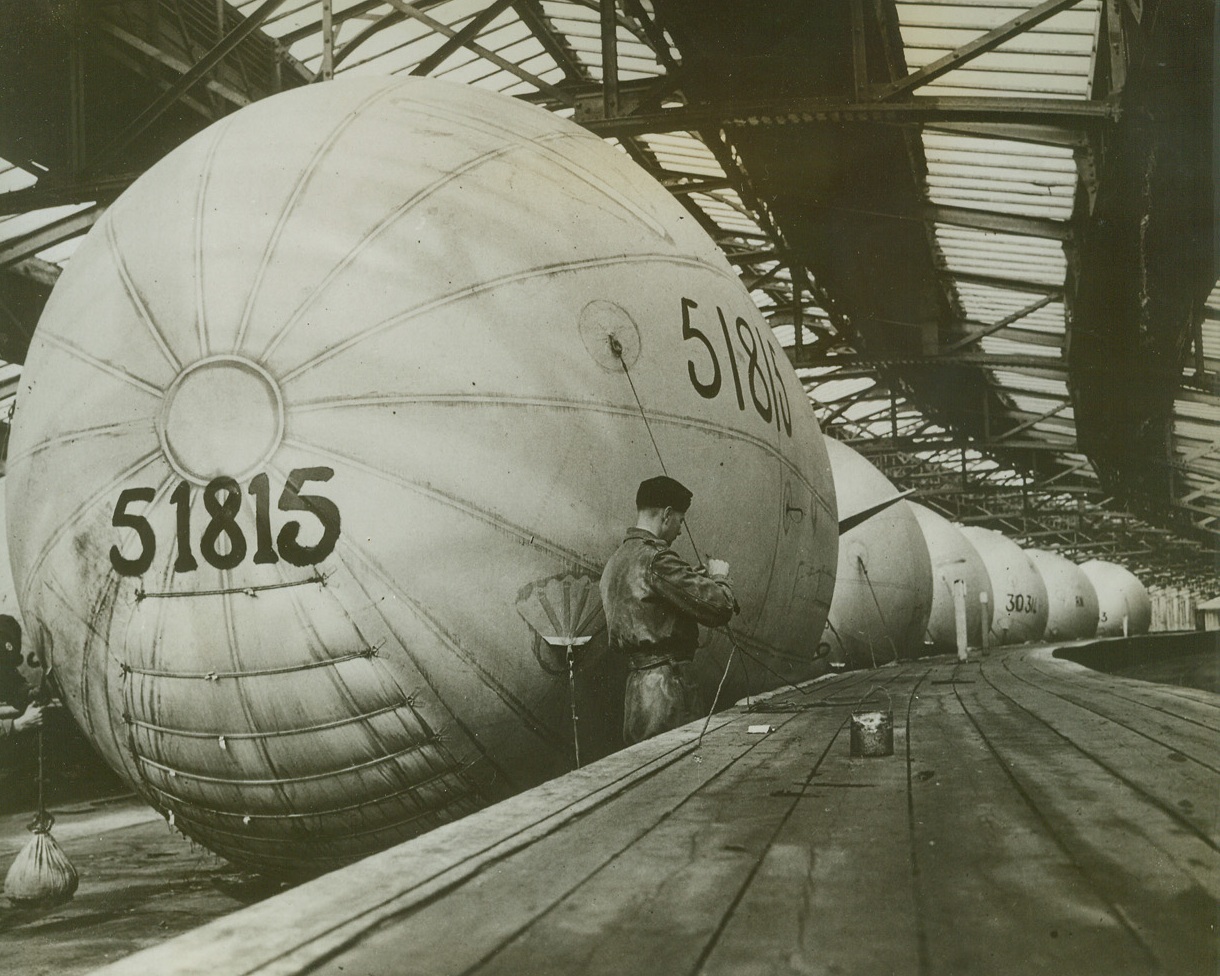
Inflation Line, 5/27/1943. SOMEWHERE IN ENGLAND—Mark VI balloons of the Royal Navy stand in line inside the inflation shed in which they are housed. Valuable because they help to protect ships from air attack, the balloons are used on drafters, trawlers, and other vessels.Credit: Acme;
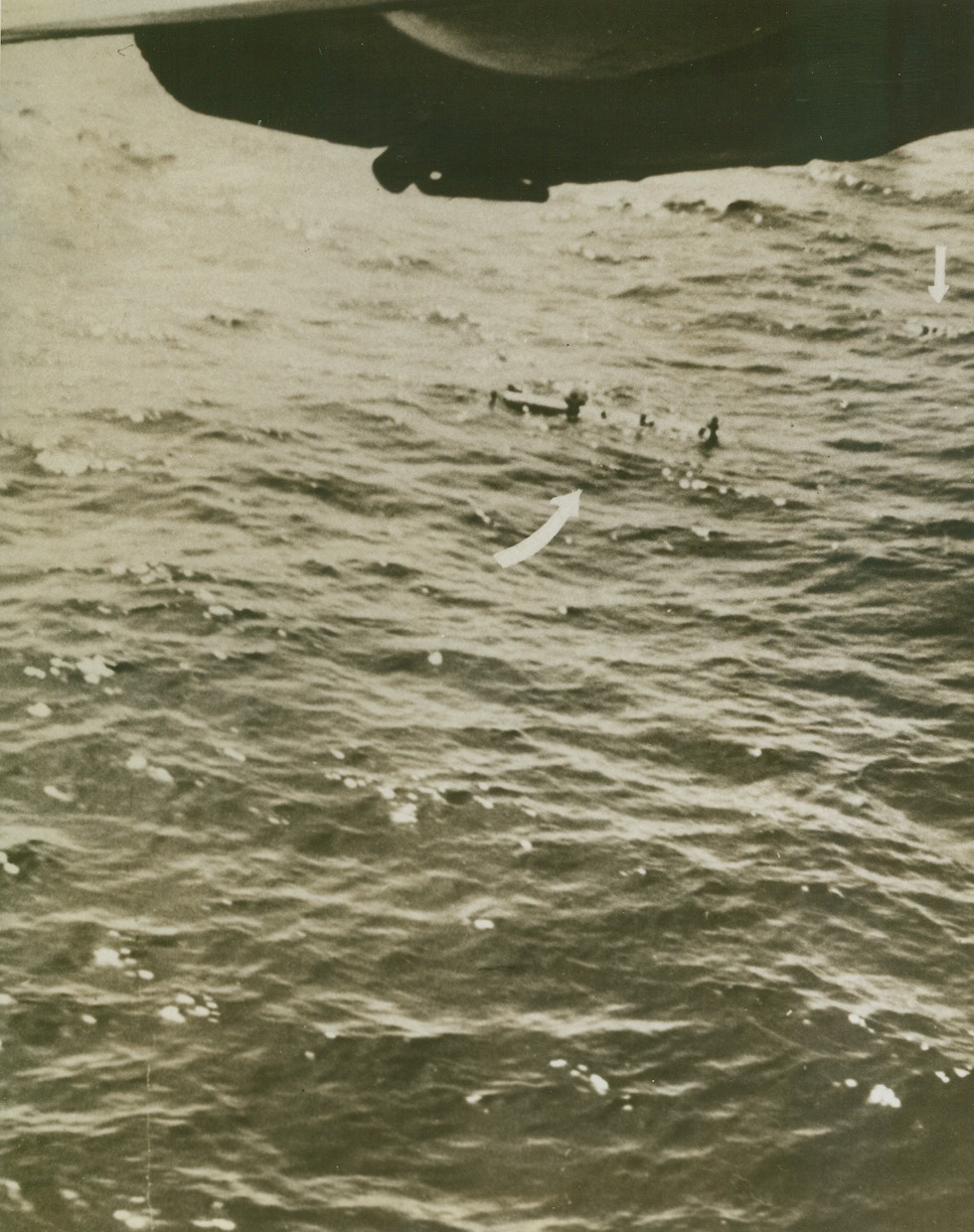
“Tidewater Tillie” Scores Again, 5/25/1943. The crew of a specially equipped Liberator B-24 bomber of the U.S. Army Air Forces anti-submarine command made this photo of a successful attack on a Nazi U-boat, proving they had scored a “kill”. Once before they had attacked an enemy sub and had been given credit for only a “probable”, because their photos hadn’t shown conclusively that the undersea boat was destroyed. This time, photos of the attack, and of the wreckage on the surface after the attack, made the “kill” a certainty. Here, after depth bombs from the plane had blasted the sub to the bottom, survivors of the crew cling to a cylindrical object, (left arrow), and others float in the water, (arrow far right): Credit Line (U.S. Army Air Forces Photo From ACME);
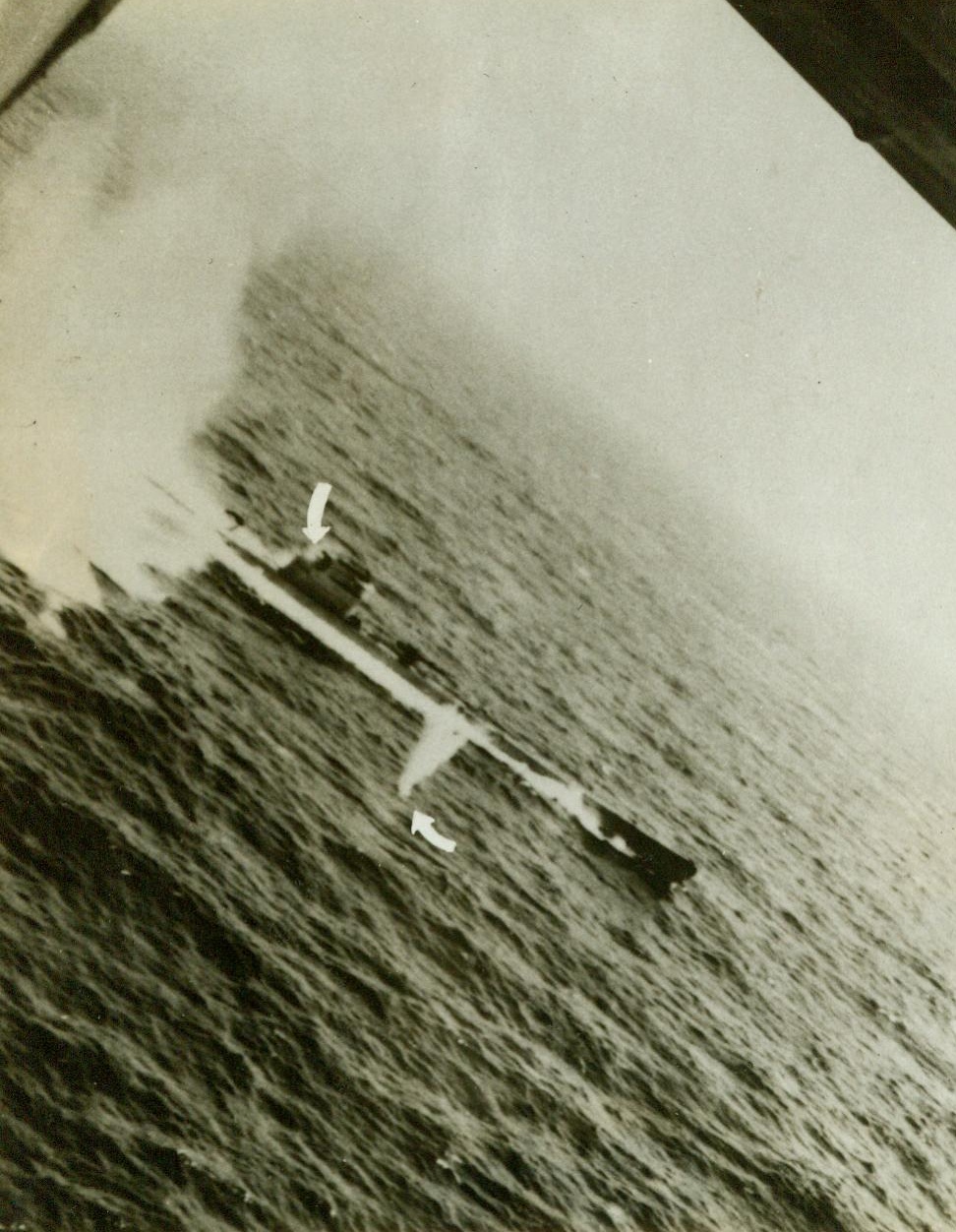
”Tidewater Tillie” Scores Again – (#1), 5/25/1943. The crew of a specially equipped Liberator B-24 Bomber of the U.S. Army Air Forces Anti-Submarine Command made this photo of a successful attack on a Nazi U-Boat, proving they had scored a “kill”. Once before they had attacked an enemy sub and had been given credit for only a “Probable”, because their photos hadn’t shown conclusively that the undersea boat was destroyed. This time, photos of the attack, and of the wreckage on the surface after the attack made the “kill” a certainty. Here, the B-24 comes in on its bomb run over the sub, its machine guns blazing. Arrow, (at left), shows a Nazi crew member hit and dropping to the deck, after an American bullet had scored a hit. Another machine gun bullet splashes into the sea, (arrow at right). A few seconds later, depth bombs from the plane blasted the sub to the bottom. Credit line (U.S. Army Air Forces Photo);
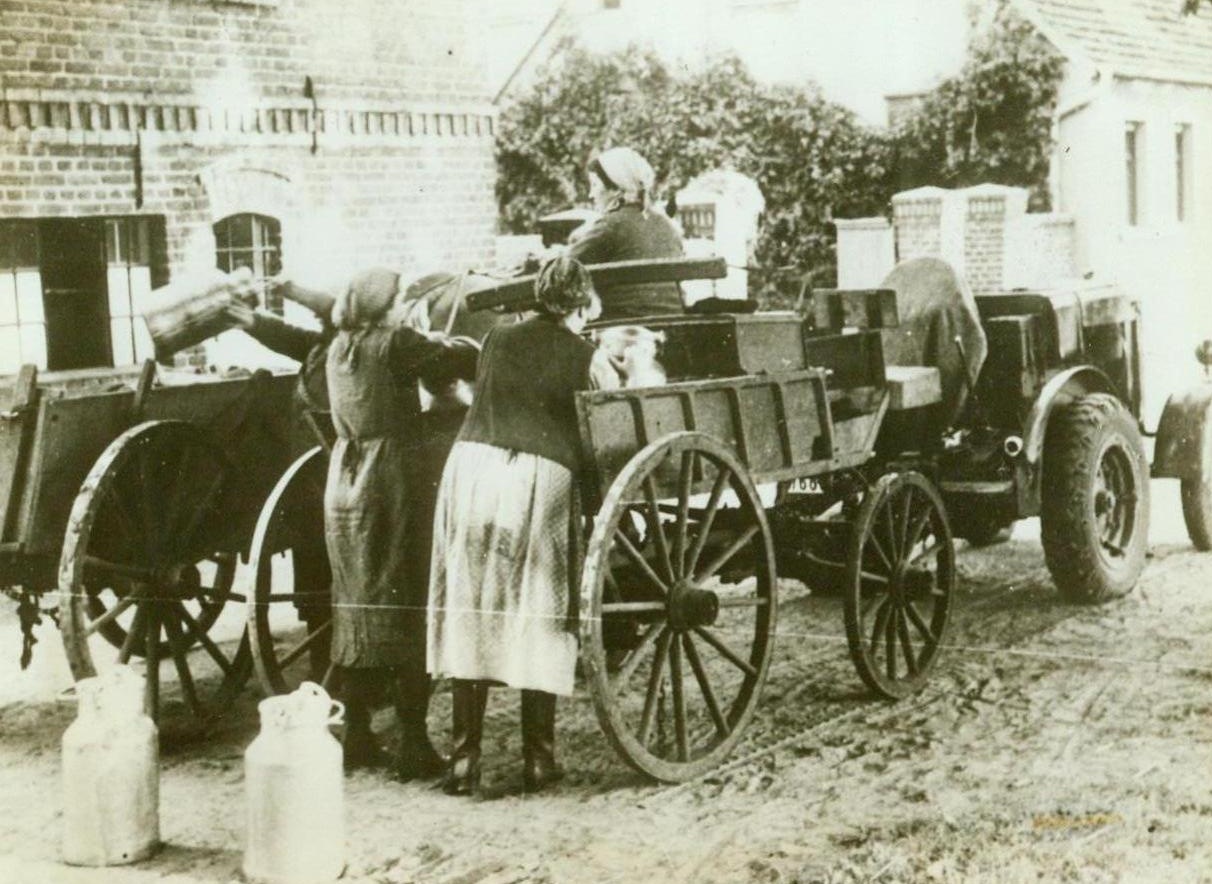
WOMEN TAKE OVER IN GERMANY, TOO, 5/22/1943. SOMEWHERE IN GERMANY – In Germany, as in every warring country, the women have taken over men’s jobs. Although Hitler would keep his women in the kitchen in peacetime, he has no objection to recruiting their labor now, to further his war. German farm women are shown loading a milk truck in this photo, which was obtained through a neutral source Credit Line (ACME);
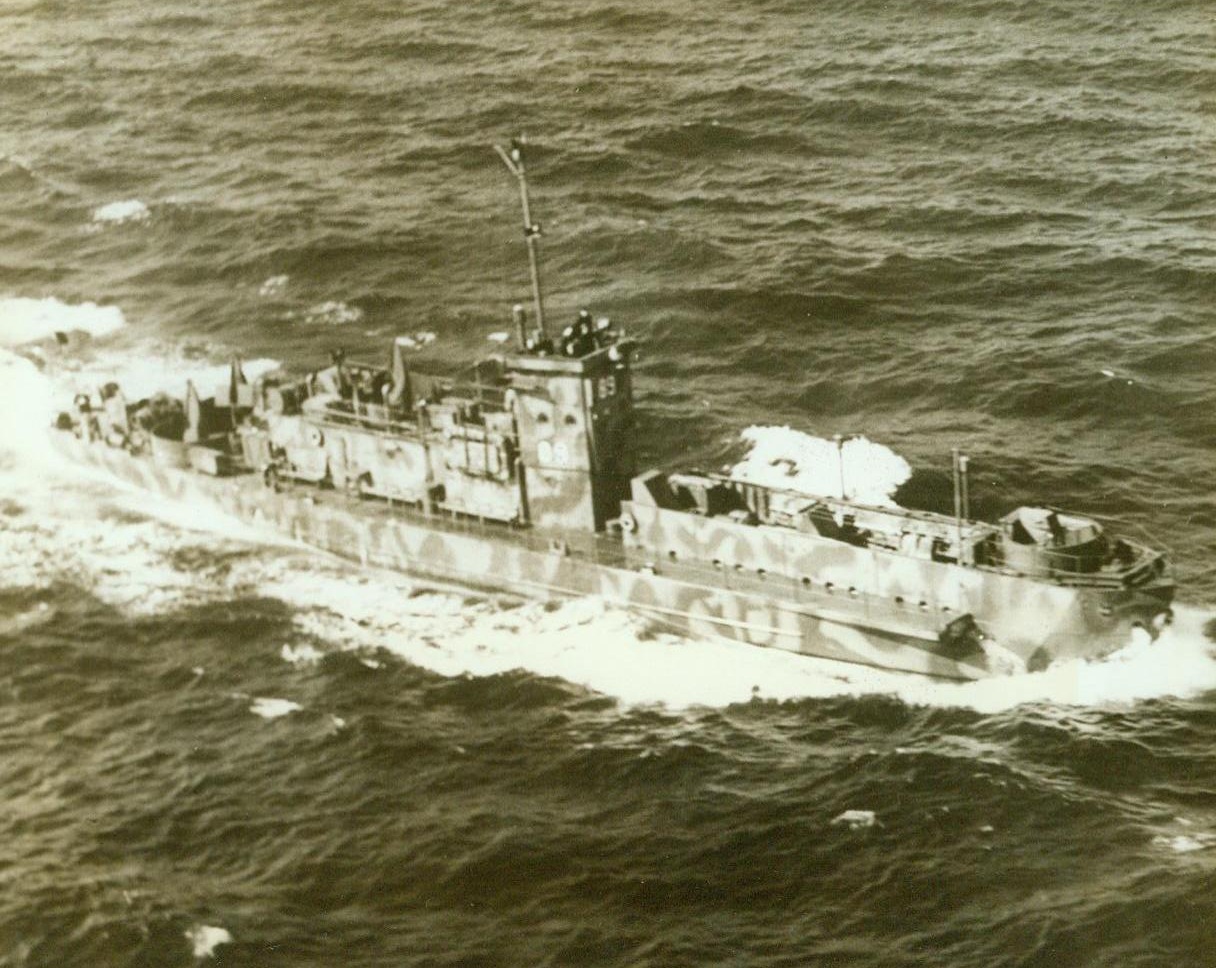
NEW TYPE INVASION BARGE, 5/22/1943. Ready to carry troops where they’re needed, this new-type invasion barge, the Navy’s L.C.I., cuts through the water off the Atlantic coast. The camouflaged vessel operates under the Navy Amphibious Force. Credit (Official U.S. Coast Guard Photo – ACME);
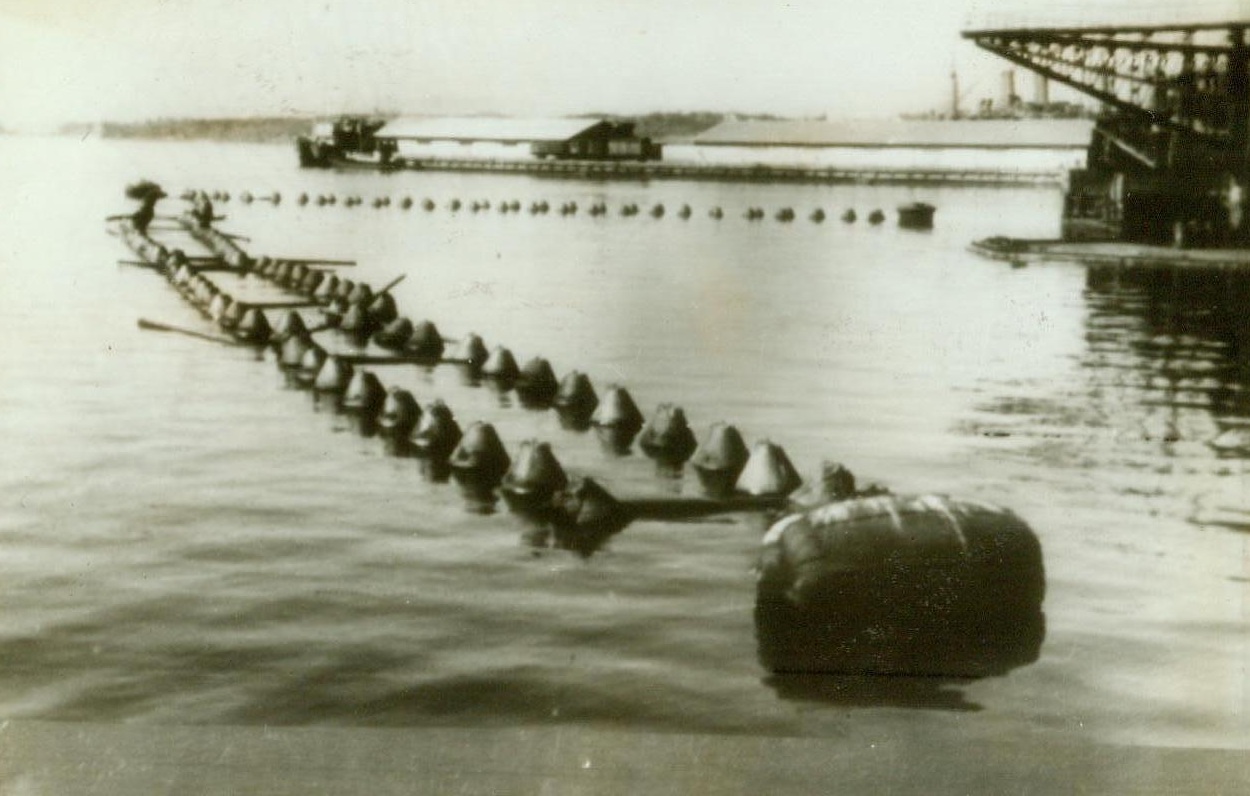
NAZIS HAVE NORWEGIAN SHIVERS, 5/27/1943. OSLO, NORWAY – Fearing Allied invasion of Norway, the Nazis have erected anti-torpedo nets in Oslo Harbor. The Germans, whose war strength is being sapped by Allied bombs, are barricading themselves behind coastal fortresses, jittery over things to come Credit (ACME Radiophoto);
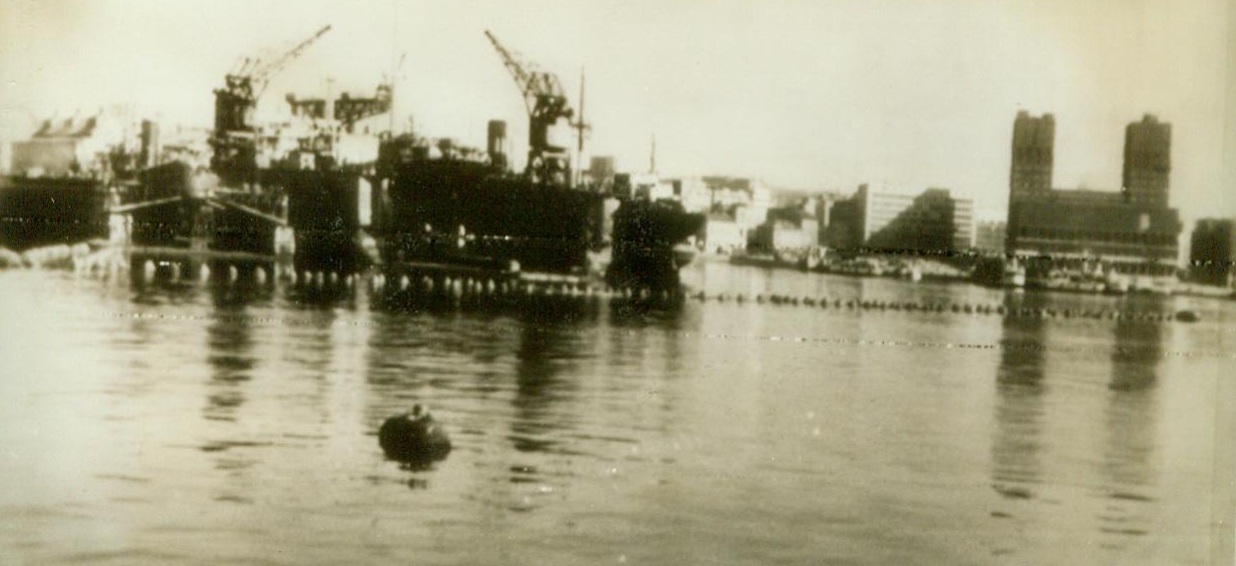
INVASION NIGHTMARES, 5/27/1943. OSLO, NORWAY – Anti- torpedo nets protecting Oslo Harbor are mute testimony that the Nazis fear invasion in Northern Norway. In the background (left) is Akers Machine Factory, the country’s biggest and (right) the Oslo City Hall, taken over by the Germans. Credit (ACME Radiophoto);
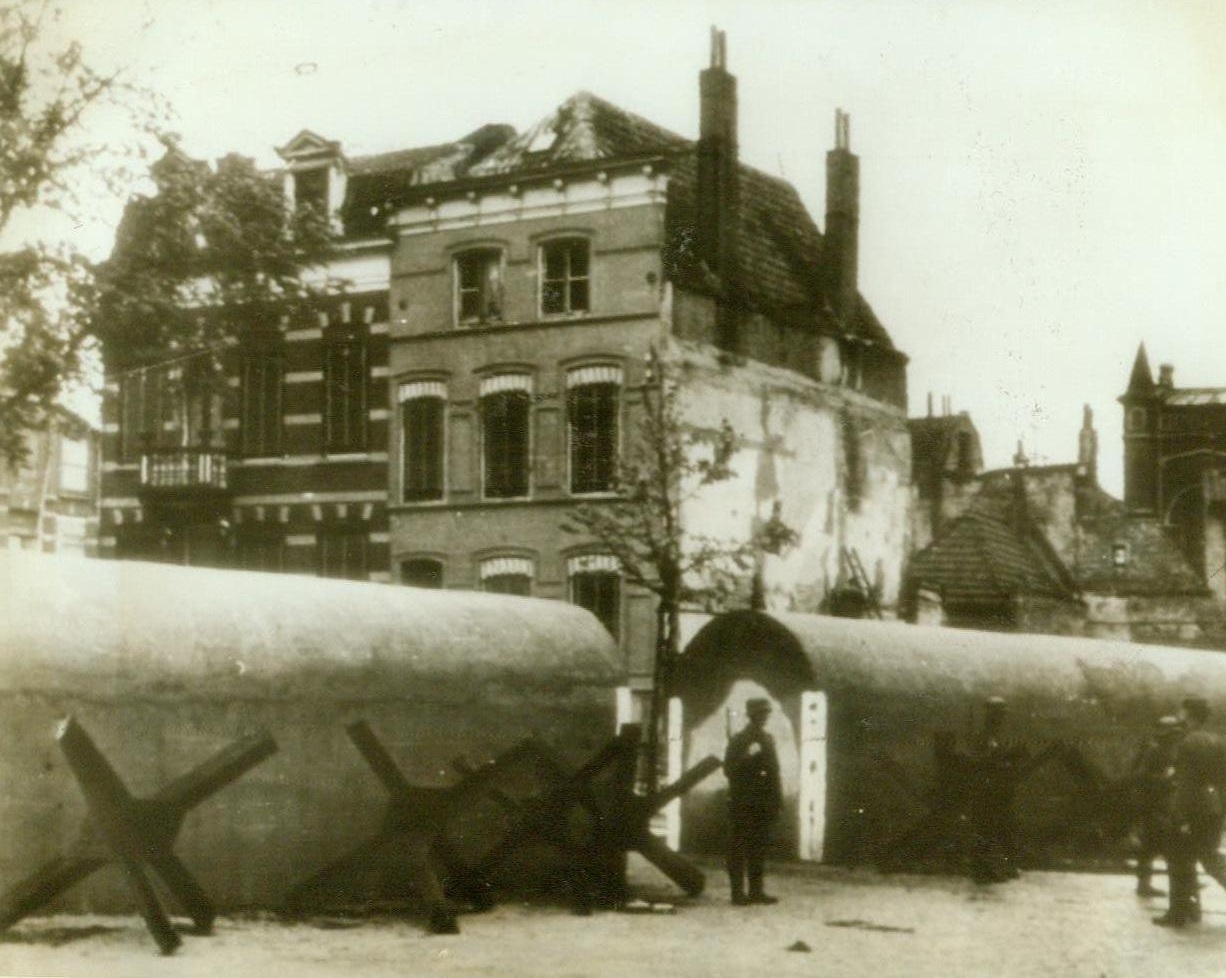
PART OF HITLER’S FORTRESS, 5/21/1943. CHANNEL COAST – As the Nazis get more and more jittery at the thought of a possible Allied invasion of Europe in the near future, their coastal defenses are being strengthened at a more feverish pace. Here’s an anti-tank wall in the harbor area of an unnamed city on the Channel coast, according to the German caption received by radio this morning from Stockholm Credit Line (ACME Radiophoto);

PLENTY OF BUSINESS FOR NAZI AMBULANCES, 5/21/1943. A wounded Nazi soldier is removed from an ambulance just back from a battlefield. Although the original German caption gave no location for this war scene, the snowy terrain indicates that it is somewhere on the Russian front. Photo arrived by clipper from London Credit Line (ACME);
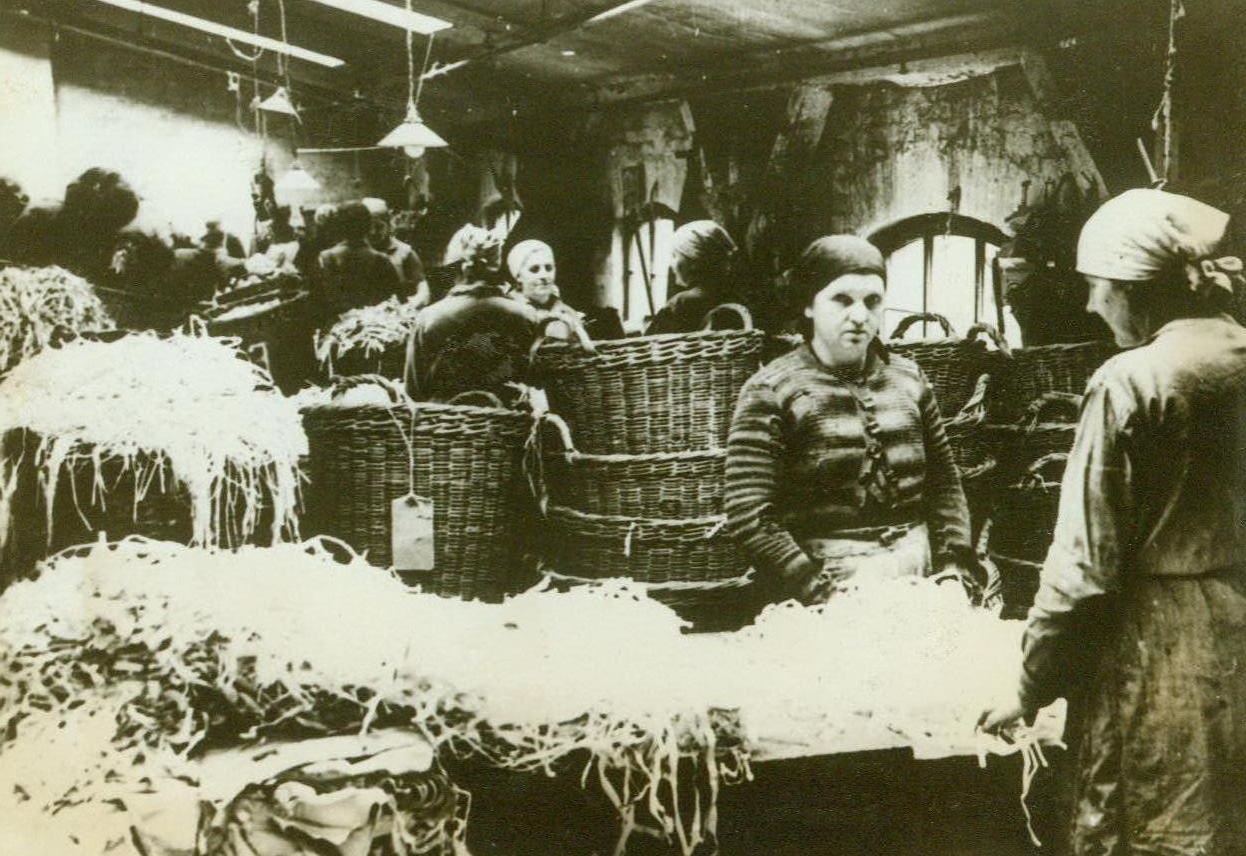
“IT IS EVERY GERMAN’S DUTY…”, 5/22/1943. SOMEWHERE IN GERMANY – “It is every German’s duty to save old paper” – So says the Fuehrer, and the German caption accompanying this photo, which was obtained through a neutral source. Working in Germany’s paper salvage campaign for 1943, these women sort old paper, into baskets. Credit Line (ACME);
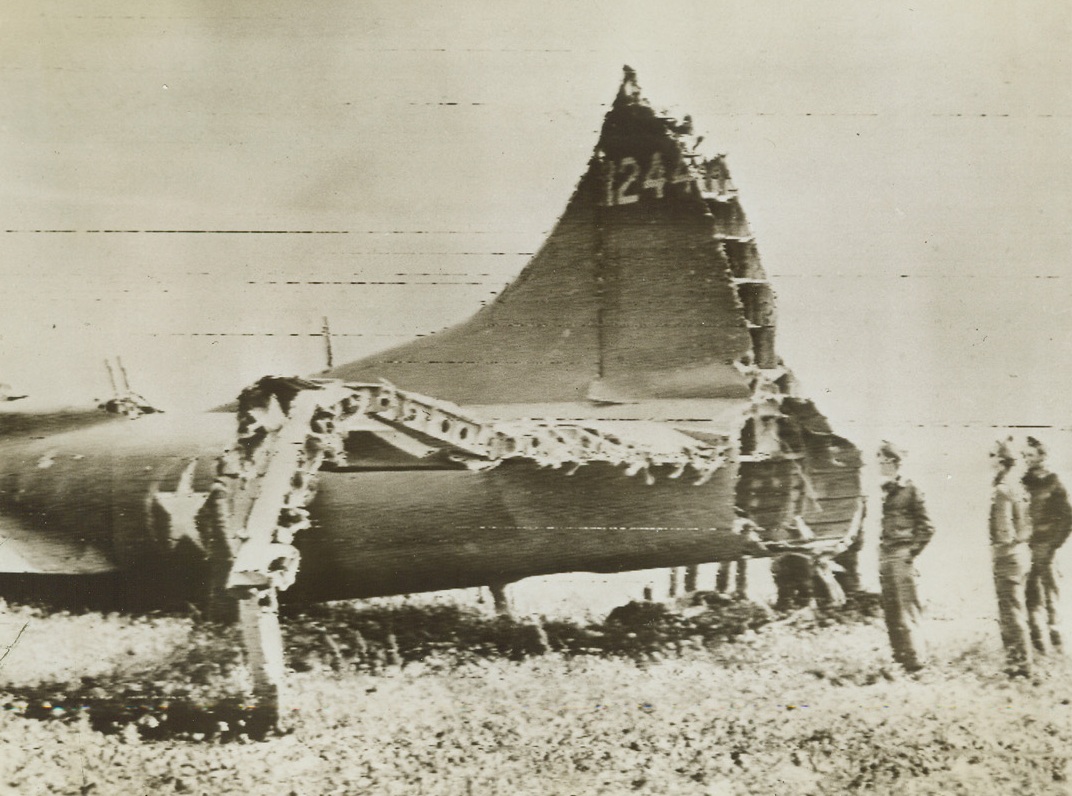
“Wounded” Warbird Comes Home, 5/21/1943. American fliers examine the battered tail section of an American Flying Fortress that managed to return to its home base in spite of damages that crippled it. The “wounded” warbird made its spectacular flight back after participating in a raid on Palermo, Sicily. Credit: U.S. SIGNAL CORPS RADIOTELEPHOTO-ACME.;
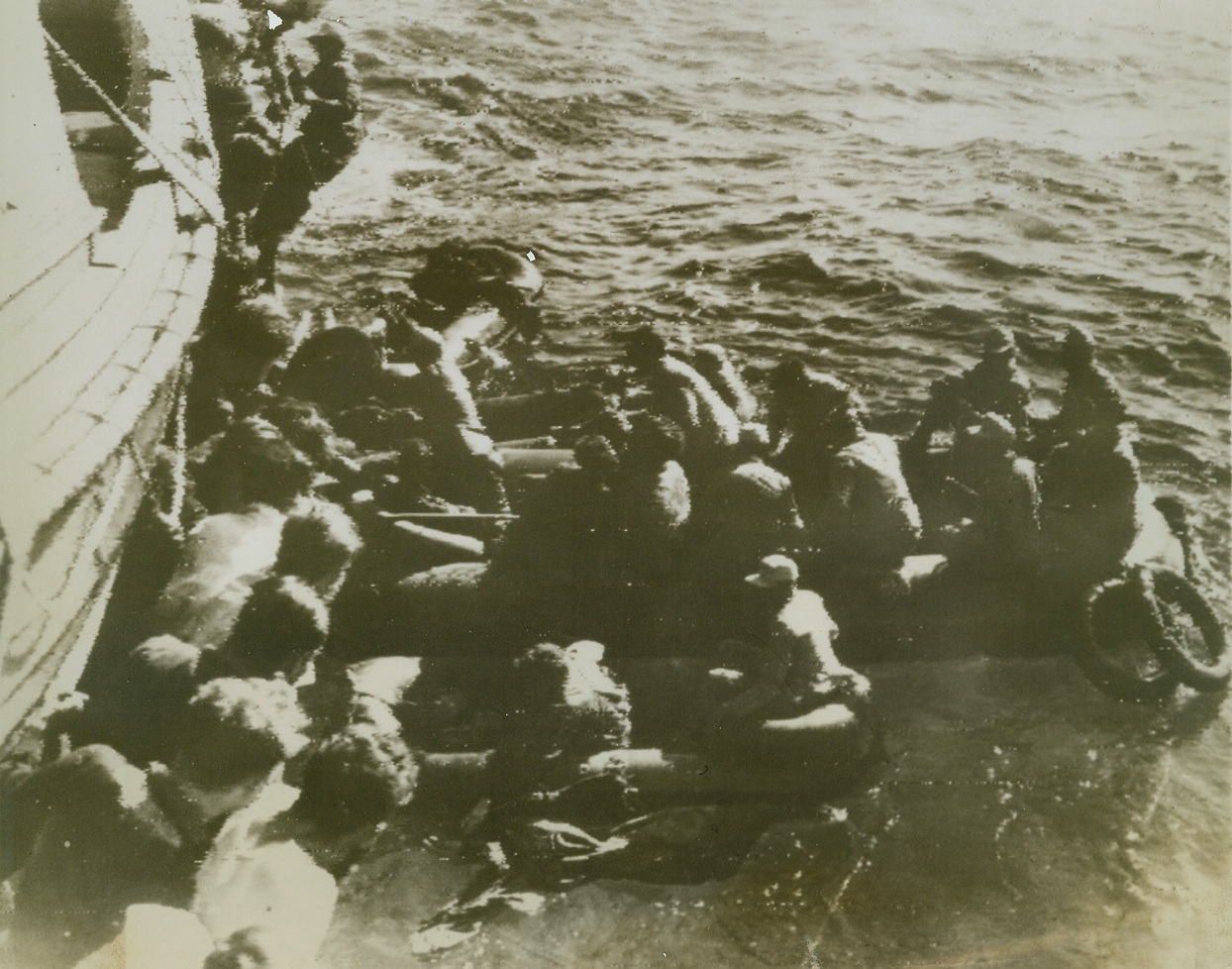
Mediterranean Round-Up, 5/20/1943. A British destroyer rounds us a load of would-be Nazi escapists 20 miles from land, midway between Tunisia and Pantelleria. Most of these Nazis are Luftwaffe anti-aircraft gunners. There would have been plenty of business for them had they escaped to the Mediterranean island, for Allied flyers are giving it a constant pounding.Credit (ACME Radiophoto);

ANOTHER PLASTERING FOR PANTELLERIA, 5/28/1943. Runways and planes at the Italian airport on Pantelleria Island become so much rubble for the ever-growing Axis wartime garbage can as they are peppered by U.S. Flyers. Precision bombing by AAF bombardiers is rendering useless airports and installations on the Italian side of the Mediterranean. Credit (Official U.S. Army Air Forces Photo-ACME);
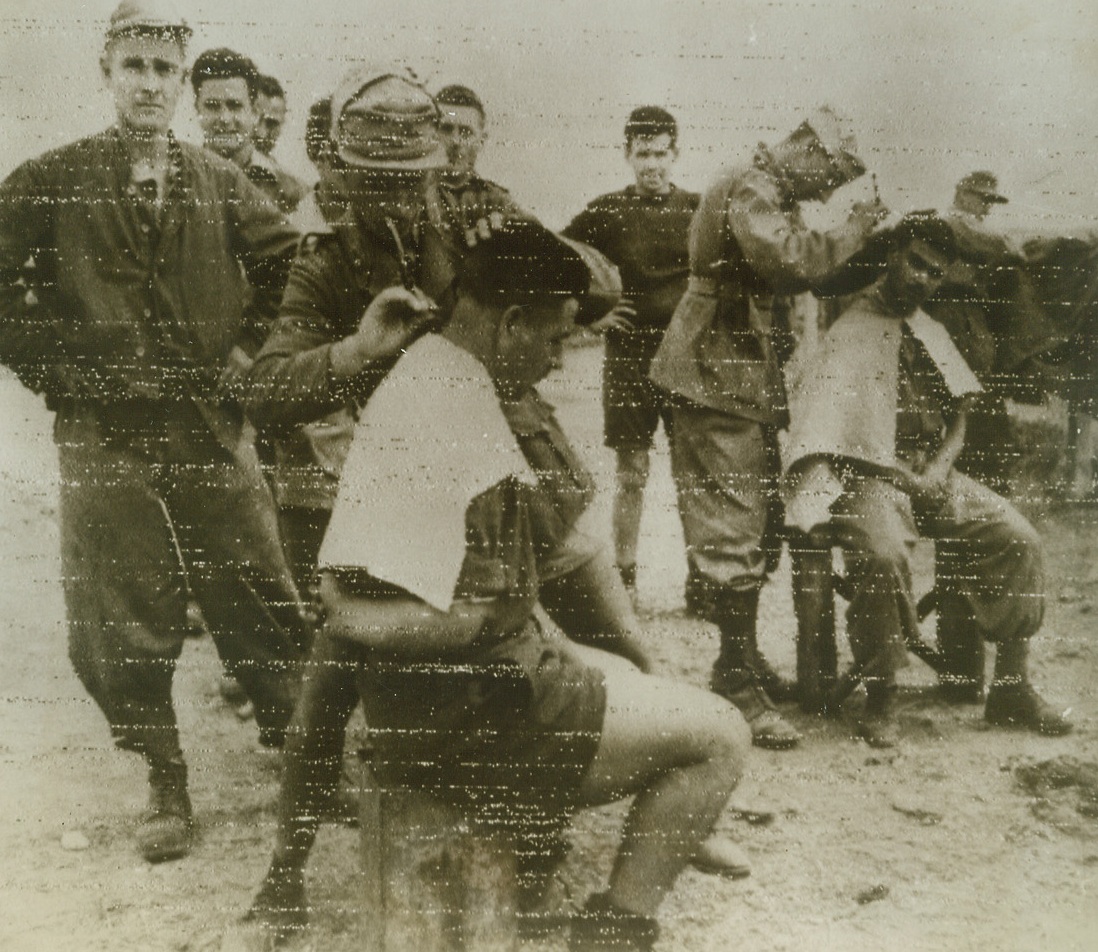
GETTING “THE WORKS”, 5/26/1943. Italian prisoners, captured during the latter part of the Tunisian campaign, get “the works” at the desert barber shop set up within the barbed wire barriers of their prisoner-of-war camp. Why the primping, boys, you aren’t’ going anywhere? Credit Line (OWI Radiophoto from ACME);
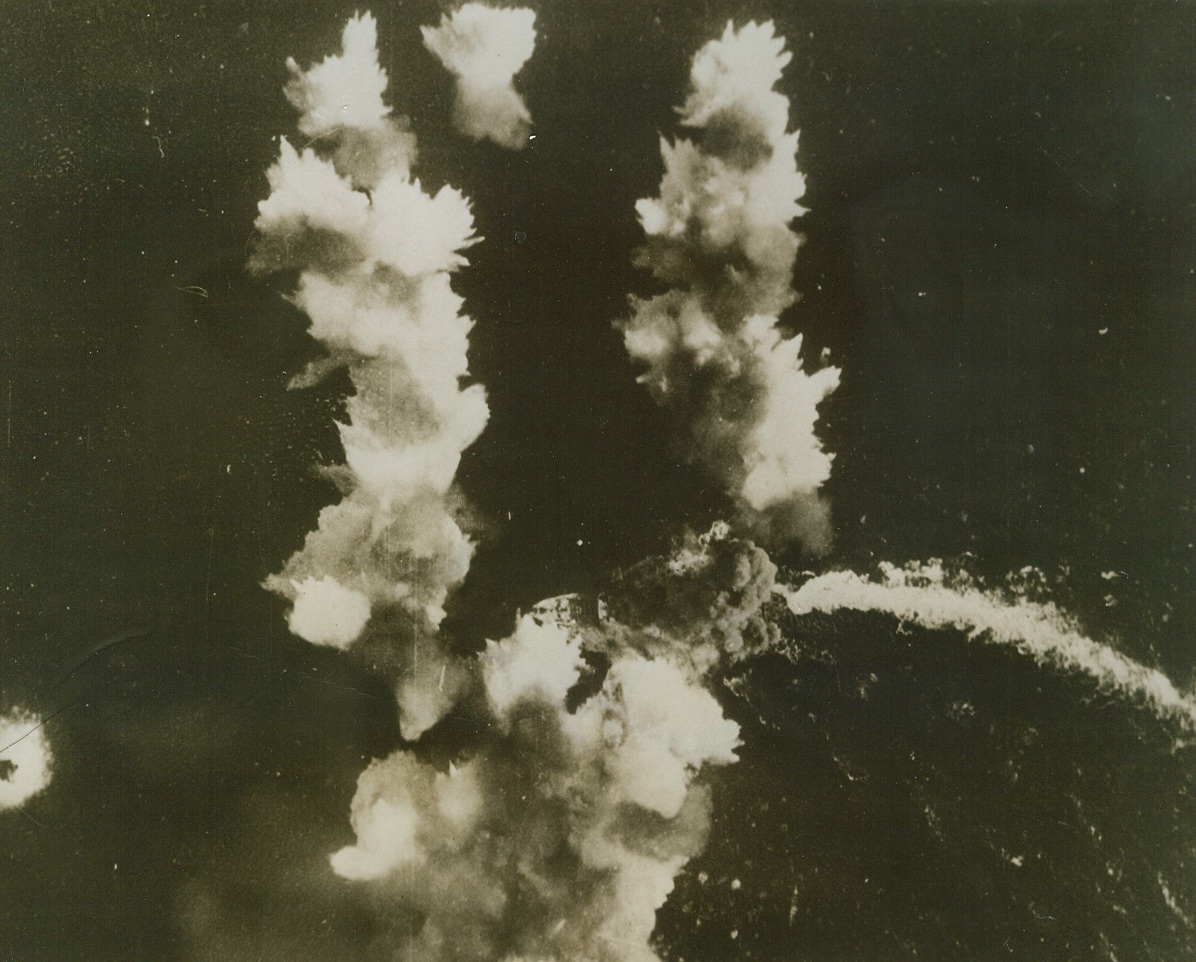
DIRECT HIT ON ITALIAN LINER, 5/26/1943. A Flying Fortress has just registered a direct hit on this huge Italian Liner, converted to carry troops, and smoke almost completely hides the vessel in this photo released in Washington today. Vessel’s wake, (at right, in photo) shows it was trying to swing in a wide circle to avoid bomb hits from the plane, which was attached to the Northwest African Strategic Air Force operating in the Mediterranean area. Credit Line (U.S. Army Air Forces Photo from ACME);
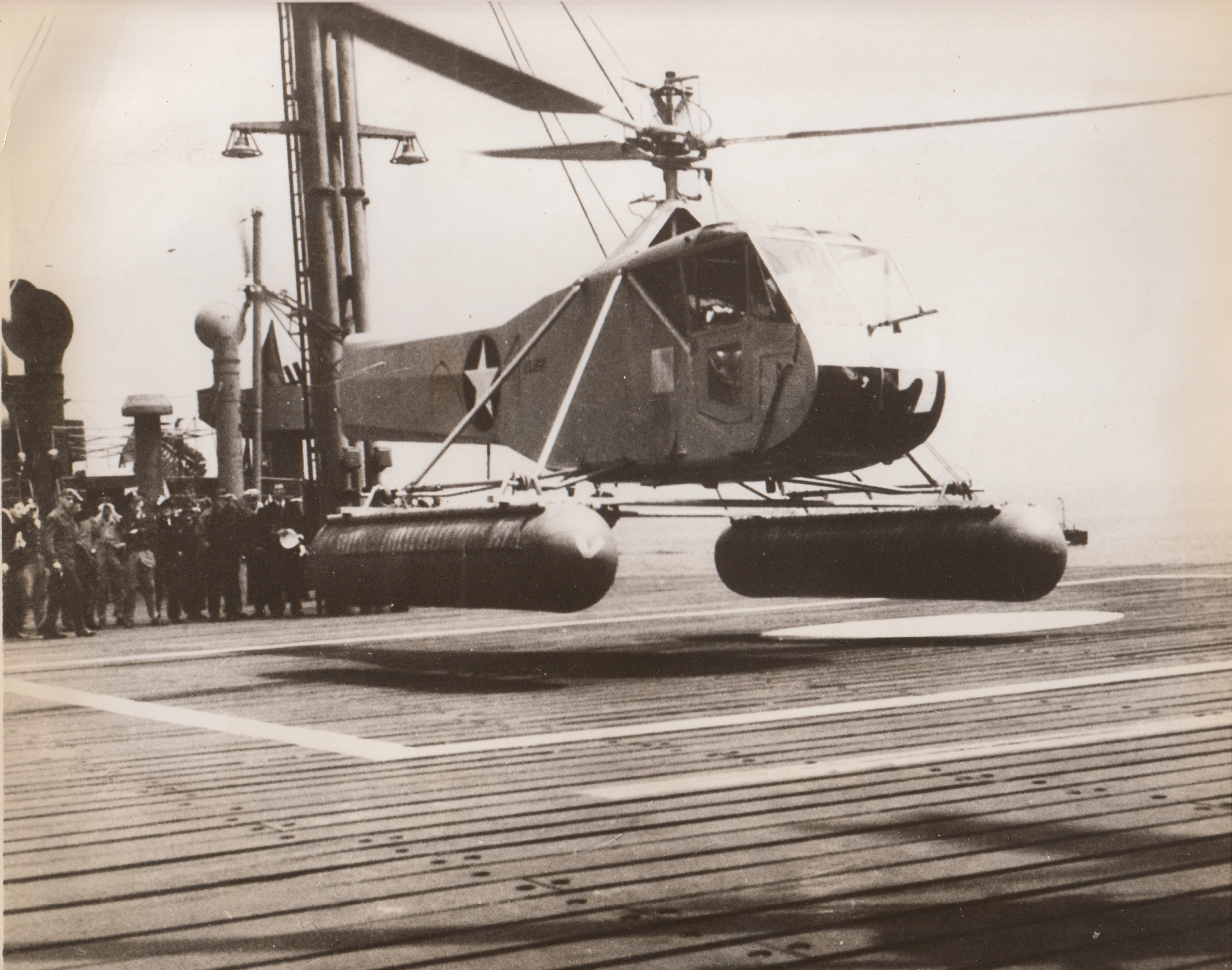
Helicopter Takes to the Ocean, 5/25/1943. A helicopter hovers over a small square marked off on the deck of a tanker, performing the tiny-space landing to prove its value as a sub fighter. In a recent demonstration on Long Island Sound, the wingless aircraft made 24 landings and take-offs from the small deck of a moving tanker. The craft, known as the Army Air Forces R-4 Helicopter, is an AAF development. A plan is in progress to install a small deck on Liberty ships to permit helicopters to be used at sea in anti-submarine duty.;
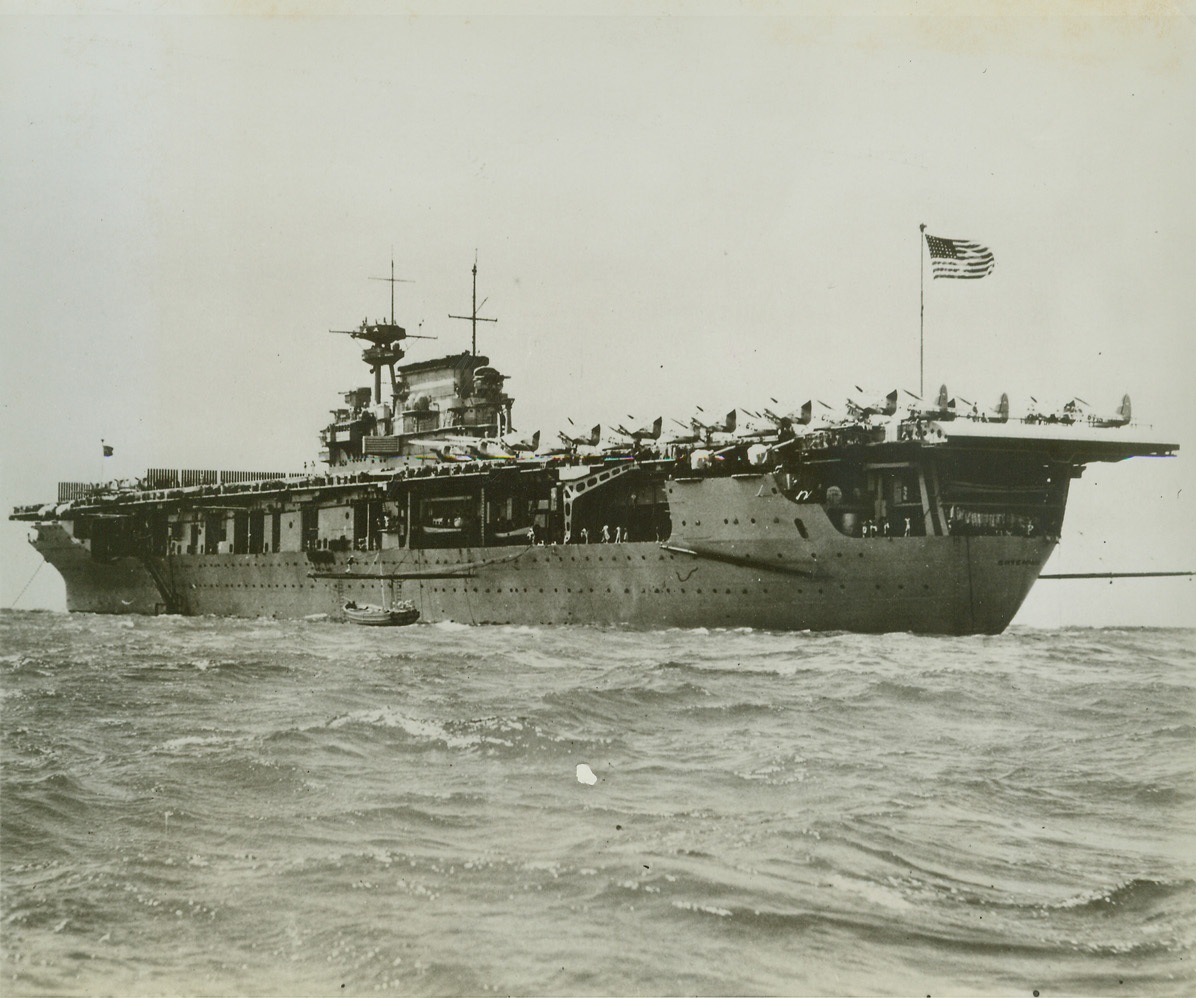
"Workhorse of War", 5/31/1943. The unprecedented combat record of the aircraft carrier U.S.S. Enterprise recently earned her a unit citation conferred by President Roosevelt. The Navy revealed tonight that the five-year-old ship has inflicted damage on the enemy estimated at eight to ten times her own cost. Planes, submarines, all types of enemy surface vessels, and shore installations have been destroyed or badly damaged in record number by the aircraft carried on the 19,900-ton carrier. Credit (Official U.S. Navy Photo-ACME);
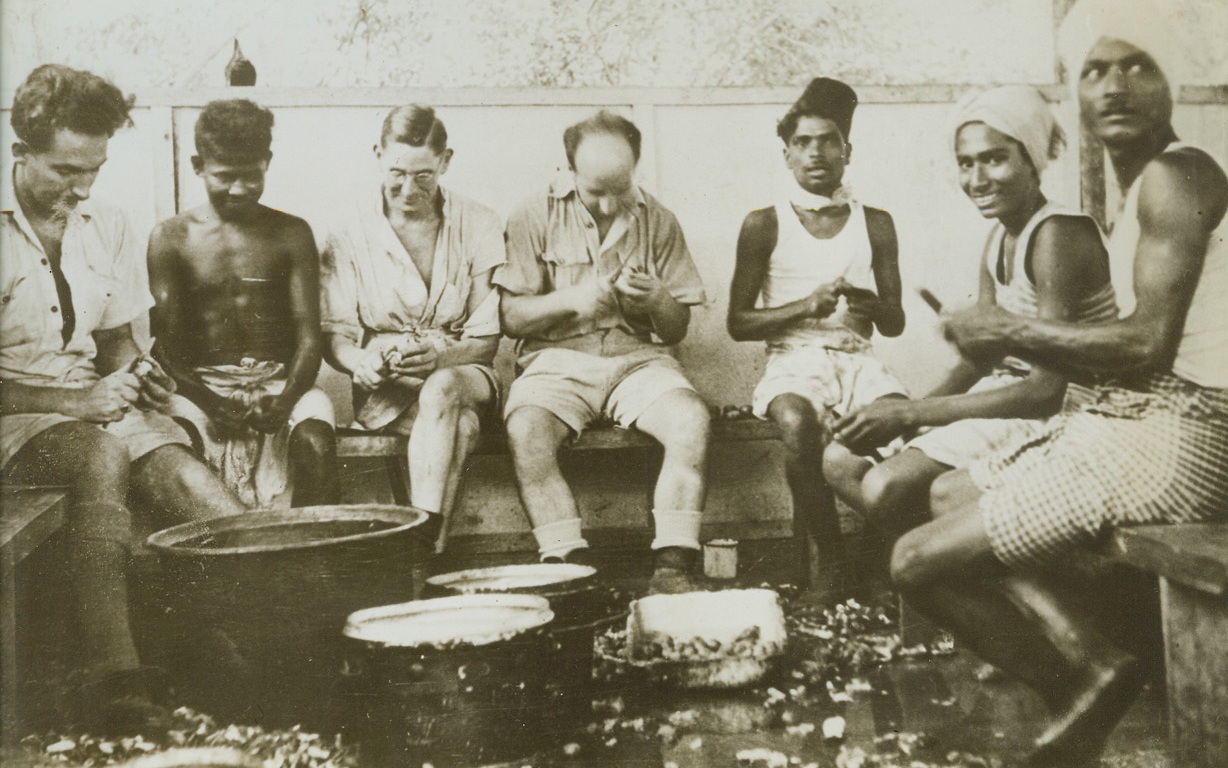
Spuds Ahoy!, 5/23/1943. Ceylon, India – Spud-hungry? Just hop an ocean liner to Ceylon – They’ve got plenty of potatoes there. This is one chore that many an American housewife would like to take over – but it’s still K.P. to the RAF men and Ceylonese who peel and peel and peel the never-ending pile of spuds. Credit: ACME;
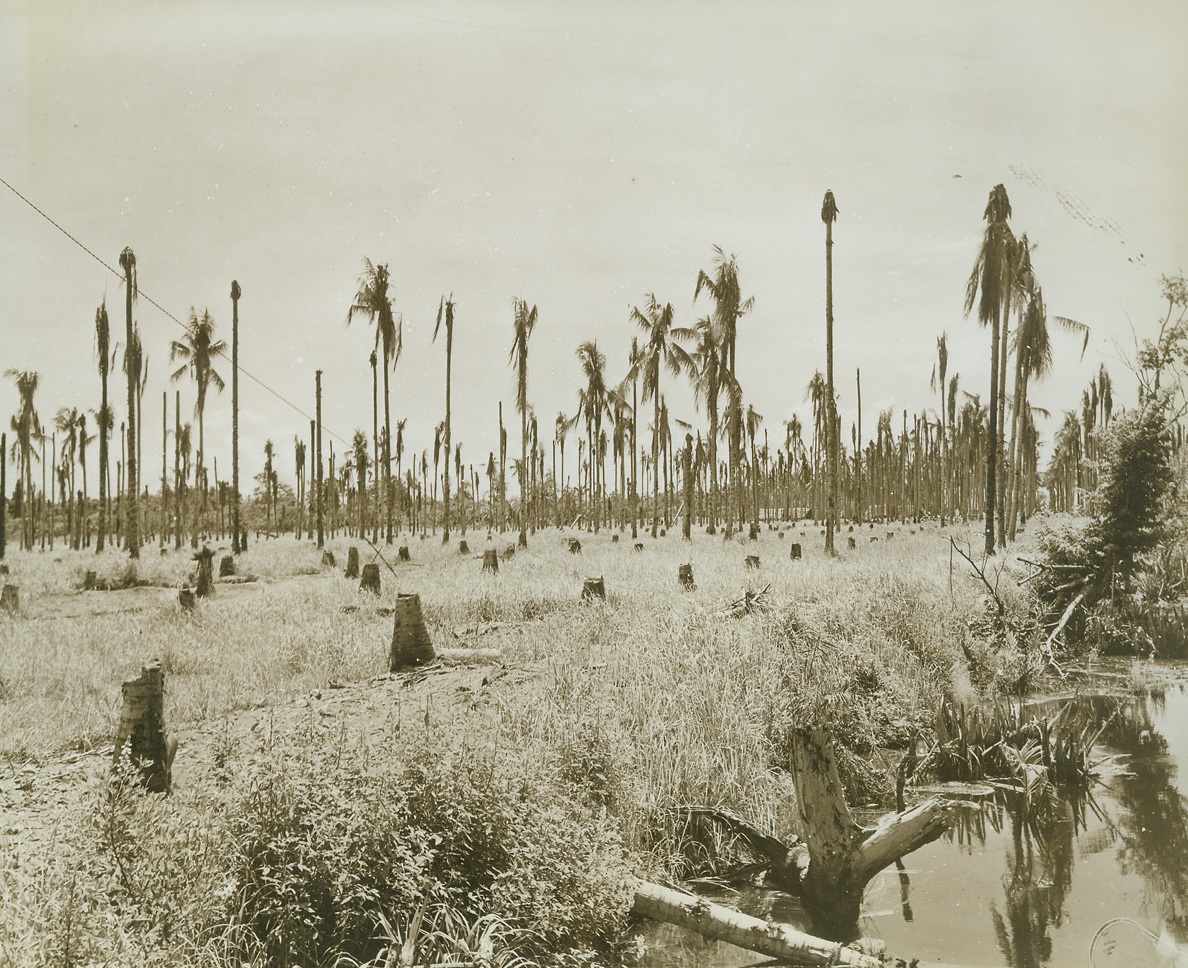
Battle Scars, 5/20/1943. New Guinea - - Although many months have passed since Jap and Allied troops fought here, time and fast-growing jungle vegetation have not yet been able to remove the scars of battle from this field in the Buna area of New Guinea. Naked, battle-scarred palms and jagged stumps still jut out from thick foliage to tell the story of the fury that raged here.Credit Line –WP- (ACME);
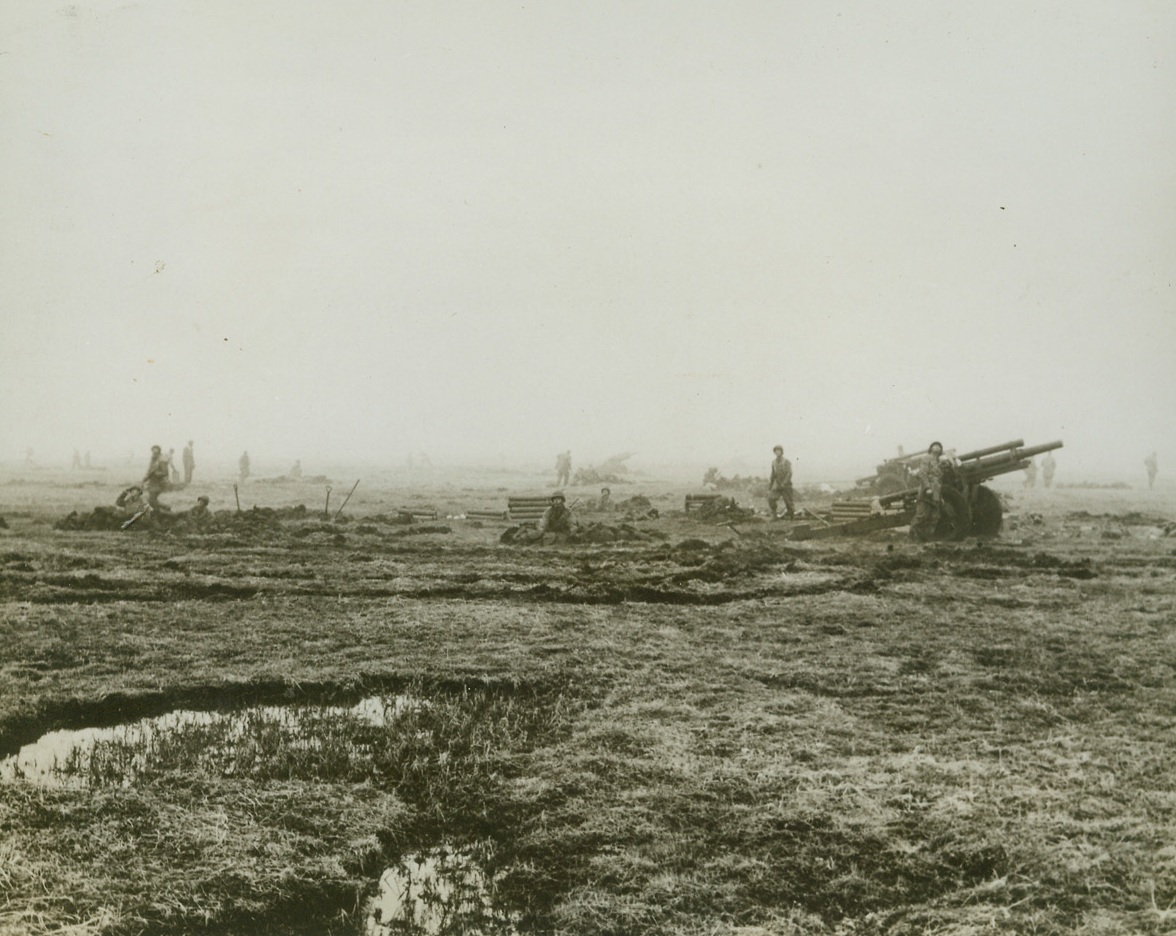
Eyes Up!, 5/27/1943. Attu—All eyes focus anxiously on the Aleutian skies as American fighting men watch their air arm fly into battle. The guns, of course, are focused on the Japs in the hills of Attu as U.S. troops begin operations on that Westernmost island of the Aleutian chain. Latest reports from Attu indicate that the island’s rough, rocky terrain may delay the final Allied push against the Japs.Credit Line (Official U.S. Navy photo from ACME);
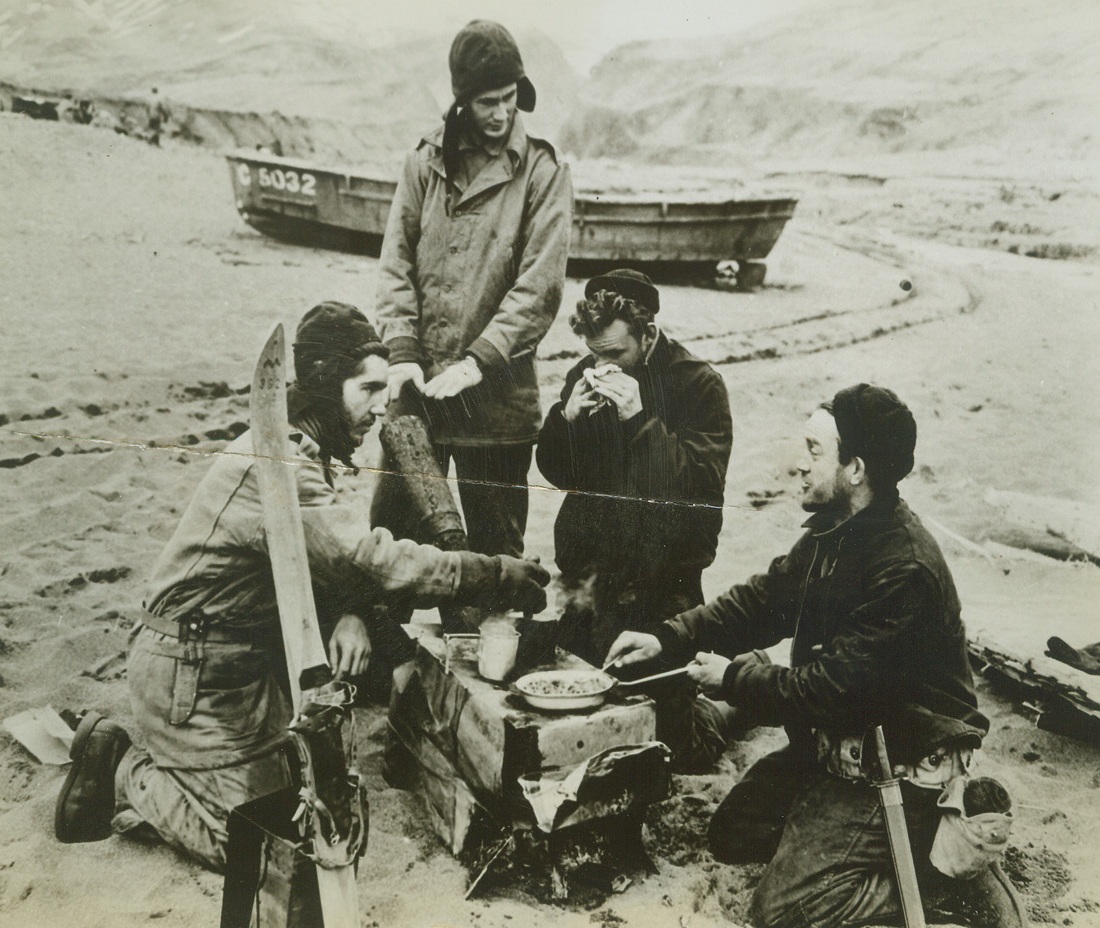
Double Purpose, 5/29/1943. Attu – A warm fire on Attu’s chilly beach serves a double purpose. It cooks a hot meal and thaws out the hands of these U.S. sailors in the Holtz Bay area of Attu island, following the landing there to drive out or destroy the Japanese Garrison. Even in May that cold-weather garb and those skies (foreground) come in handy in the Aleutians.Credit (Official US Navy photo from ACME);
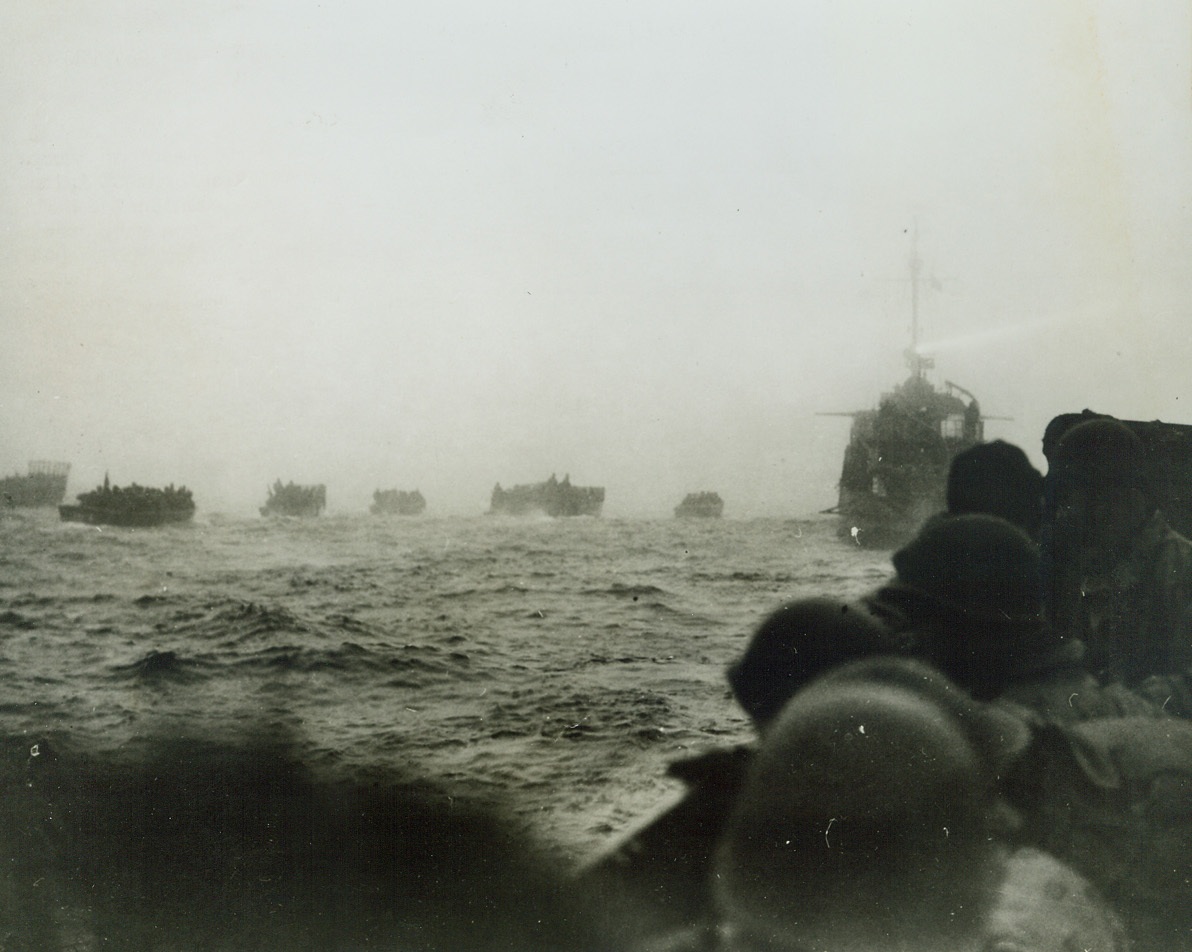
First Photos of Our Attack on Attu, 5/26/1943. As American troops landed on Attu, Aleutian islands, May 11, 1943, a Navy combat photography unit accompanied the first wave of American troops ashore at Japanese-occupied Attu, the Westernmost island of the Aleutian chain. This photo was made at the start of the attack and shows that landing boats having been put over the side of the transports are beginning to move towards the beach. The searchlight of the destroyer cuts thru the fog like a pencil.Credit Line (U.S. Navy official photo from ACME;
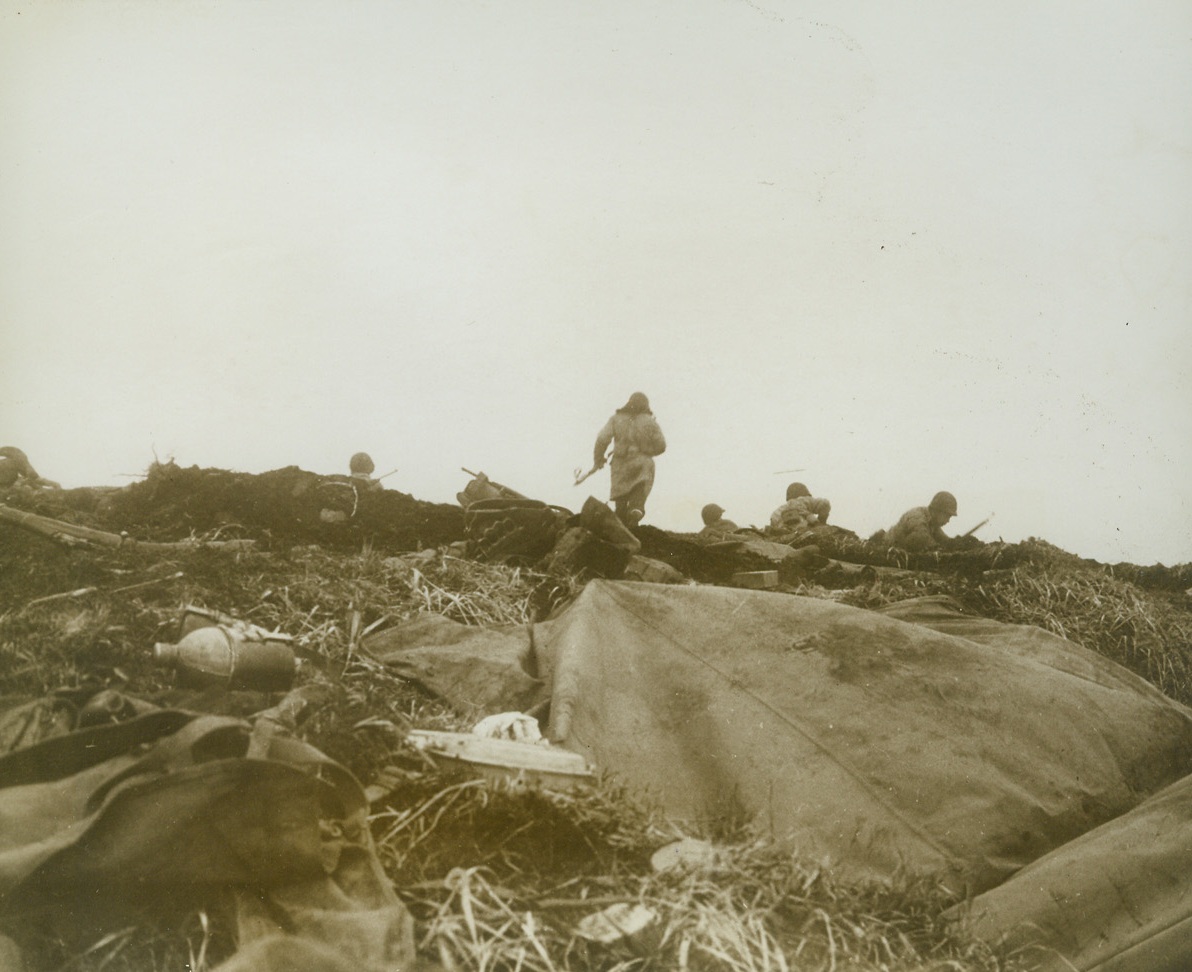
First Photos of Yank Landing on Attu, 5/26/1943. Washington, D.C.- - This photo, one of the first taken of the landing of U.S. troops on Jap-held island last May 11th, was taken by a Navy combat photographer and released in Washington today. Cameramen who took these photos of the landing at two points on the island, Massacre Bay and Holtz Bay, were under Jap fire many times. Here, U.S. troops advance in the face of enemy fire. This is a front line shot made just as a bank of fog came rolling in. While this photo was taken, Jap bullets were singing by.Credit Line (U.S. Navy photo from ACME);
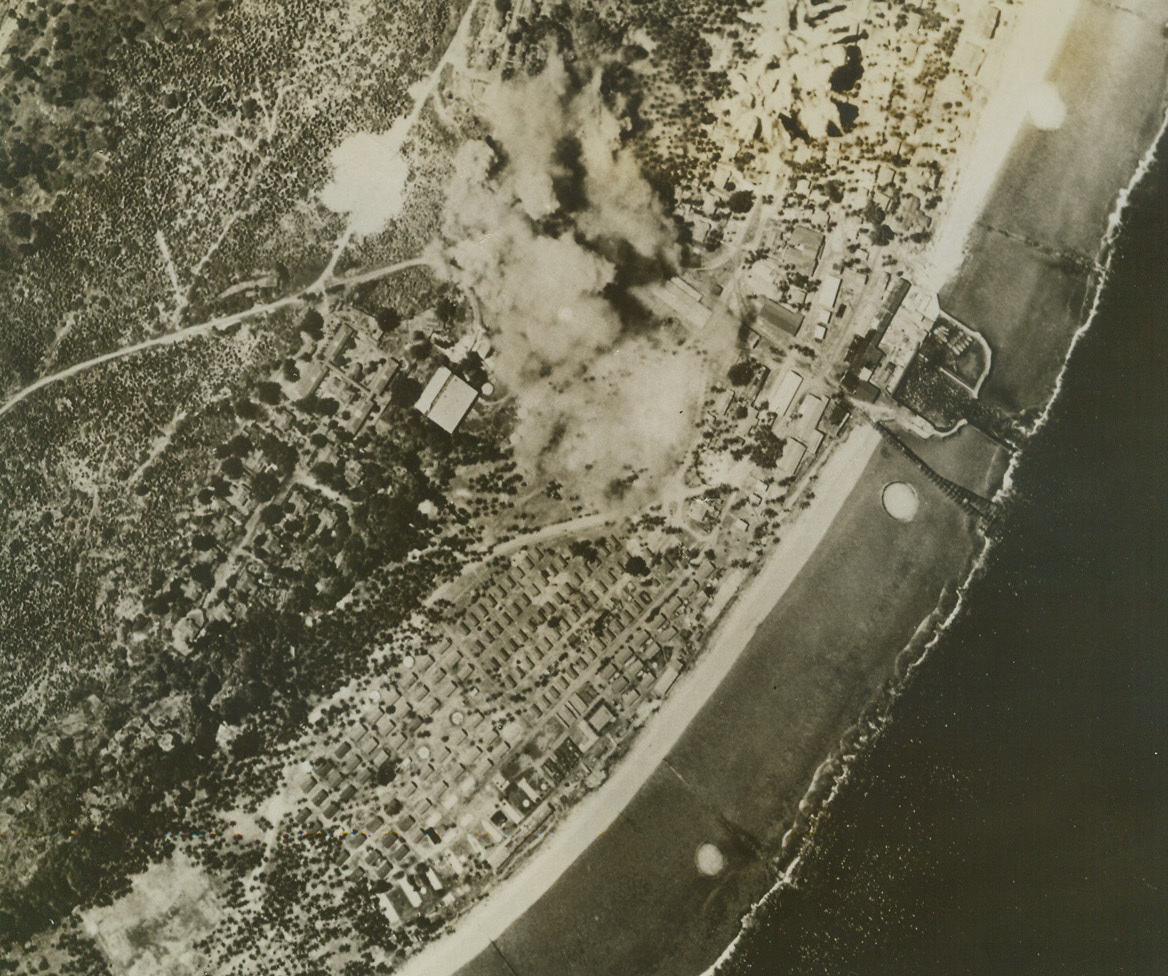
Bombs Over Naru, 5/28/1943. Thick smoke clouds rise from Jap phosphate works on Nauru Island as American bombs find their mark on that South Pacific island which lies in the Gilbert Island group Northeast of Guadalcanal. Five to seven Japanese Zeros were shot down in the Nauru raid, with no American planes lost. Funafuti, largest of the Ellice Islands, which was occupied by American forces in April, served as a base for the raiders.Credit (U.S. Army Air Forces photo from ACME);

Supplies Come to Attu, 5/29/1943. Attu- - Crates of supplies litter the beach of Attu as landing barges bring more supplies ashore to American fighting men. The equipment will be carried inland over newly constructed roads, which are the dark strips that wind across the top of photo. Latest reports from Attu indicate that the beleaguered Japs in the Chicago and Sabana Bay areas again gave ground before assaults of American troops, now inching their way forward to eliminate the remnants of enemy forces still holding positions on the Island.Credit Line (Official U.S. Navy photo from ACME);
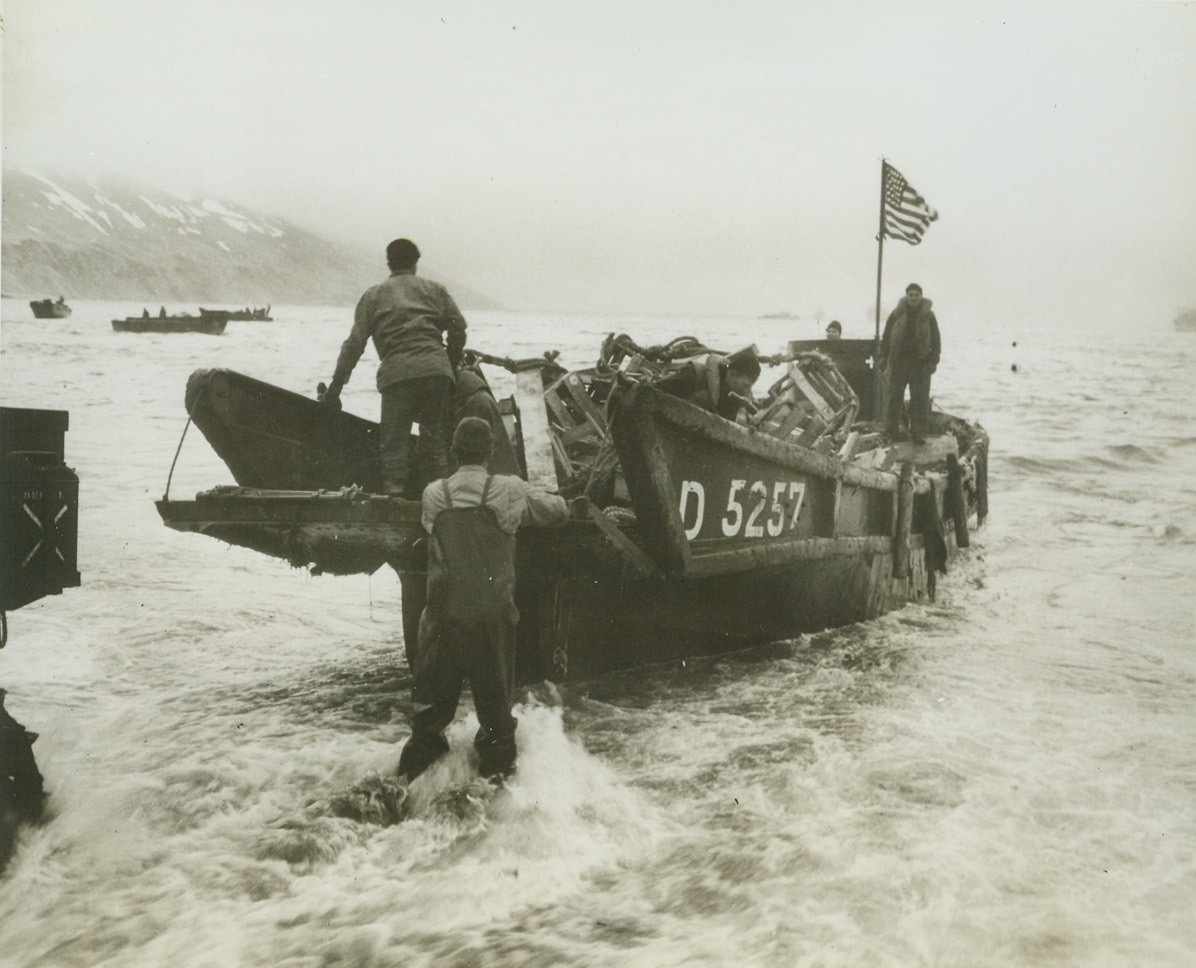
“Old Glory” Takes Possession, 5/27/1943. Attu – The American flag flutters from a mast in this captured Jap landing boat as our men bring it ashore on the beach of Attu’s Massacre Bay. Latest reports from that Aleutian Island indicate that fierce hand-to-hand fighting is now under way in the primitive wilds of Attu, with U.S. troops believed to be hacking their way through death traps with bayonet and grenade.Credit Line (Official U.S. Navy photo from ACME);
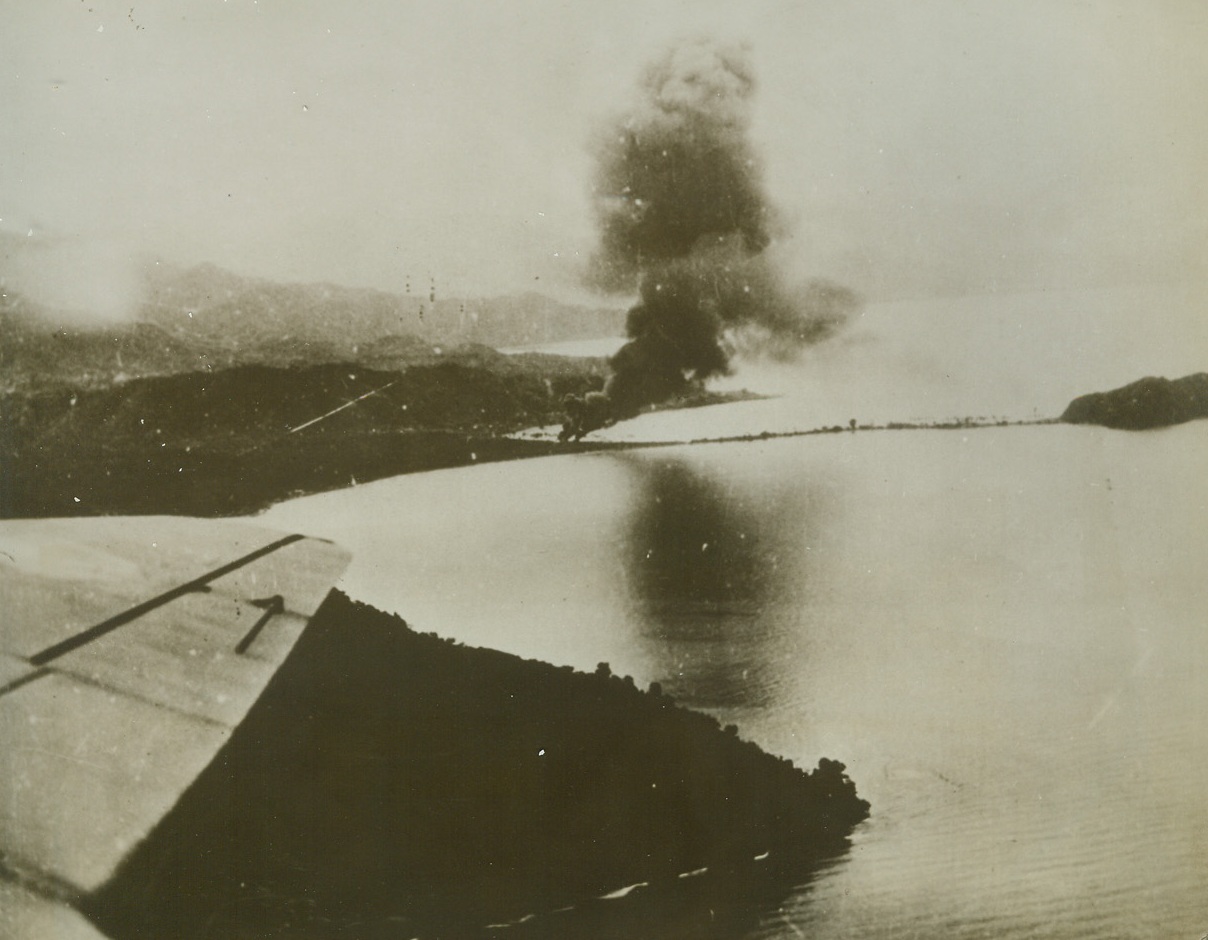
Allies Attack Salamaua, 5/20/1943. This photo, released in Washington today, shows smoke rising from fires set by Allied bombs on the Jap-held base at Salamaus, New Guinea, recently. A wing of one of the bombers making the raid shows at lower, left (photo above). It was announced today that allied planes had again raided Salamaua, attacking the airdome and town area and starting fires in enemy installations along the Francisco River.Credit Line (U.S. Army Air Forces photo from ACME);
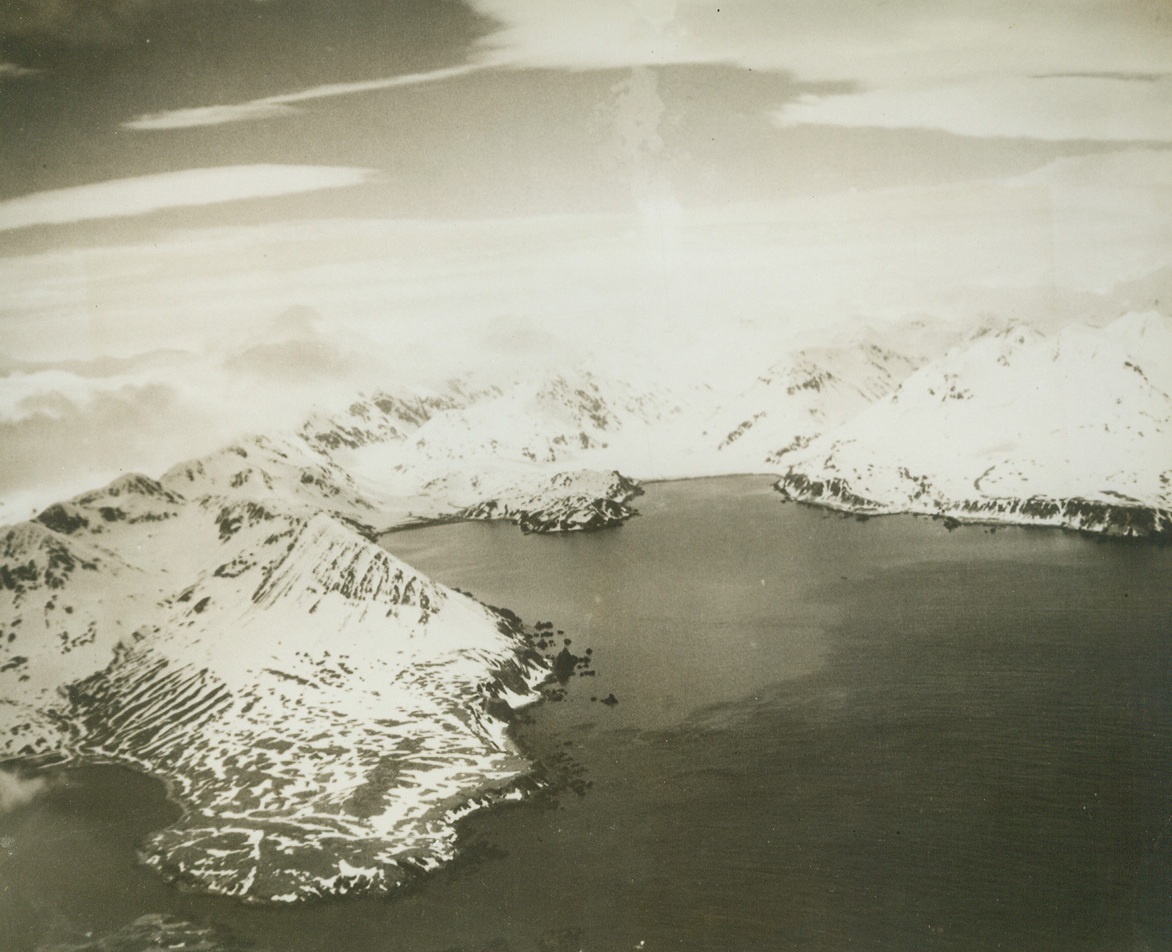
WHERE AMERICANS ADVANCED ON ATTU, 5/19/1943. Advance patrols of American forces which landed in the Holtz Bay and Massacre Bay area have joined. The tow arms of Holtz Bay are shown in the center of the photo, American forces attacked Jap positions on the high ground between the arms and took possession of the area. As the forces from Massacre Bay (not shown) advanced northward, the Holtz Bay units took possession of the high ridge to the southeast (from center of the picture to the left). The advance units from Massacre Bay and Holtz Bay met in a pass, which has been cleared of enemy troops. The troops withdrew toward Chichagof Harbor (extreme lower left). The village of Attu, only settlement on the island, faces Chichagof Harbor. Credit: U.S. NAVY PHOTO FROM ACME.;
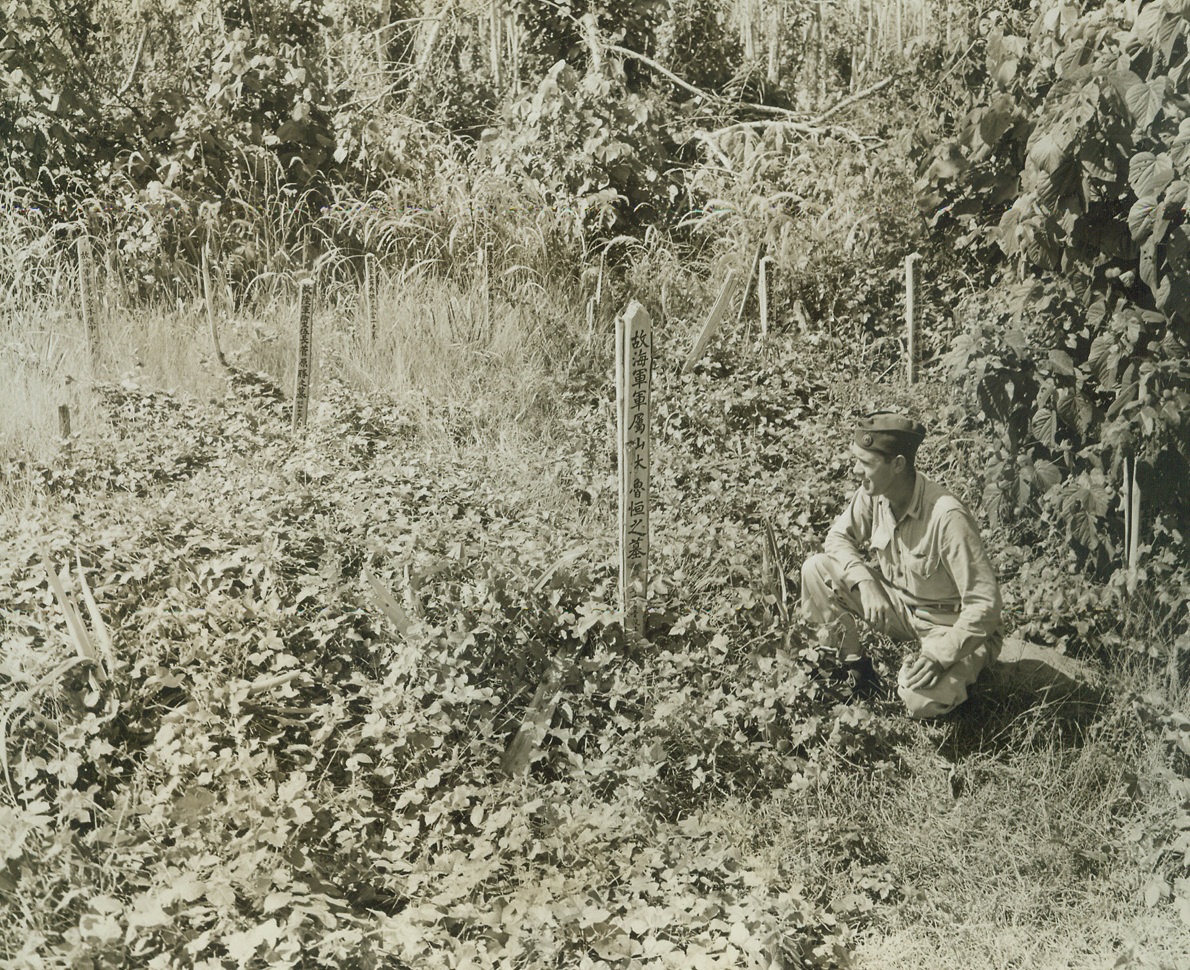
HERE LIES, 5/20/1943. NEW GUINEA—Deep in the heart of New Guinea’s Sananada Jungle, slender tombstones jut out of the foliage to mark the resting place of Japs who fell in conflict with Allied forces. Tom Yarbrough, a War Correspondent, reads the inscription that marks the grave of Rotsune Yamamoto of the Jap Navy. Credit: ACME;
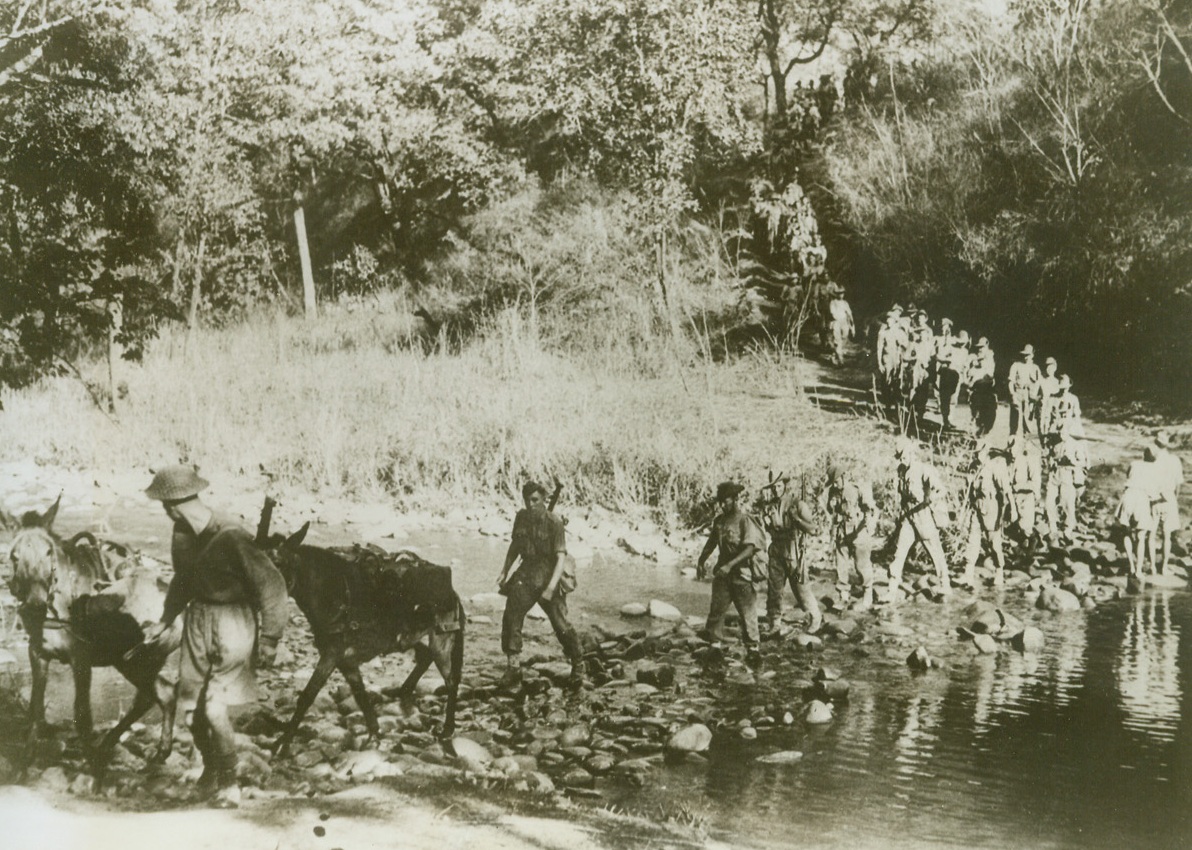
STEPPING STONES TO BURMA, 5/21/1943. BURMA—Stepping stones help Allied soldiers and their supply mules to cross this jungle stream on the narrow road to Burma. Cut through jungle, forests and mountains; this road must serve as a supply route for the Allies until the Japs can be chased from Burma and the Burma Road reopened. The key to China, which must be given military aid before a successful attack on the Japanese empire can be launched, Burma is probably the center of attention in long-range Pacific strategy discussions now being held in Washington. Credit: ACME.;
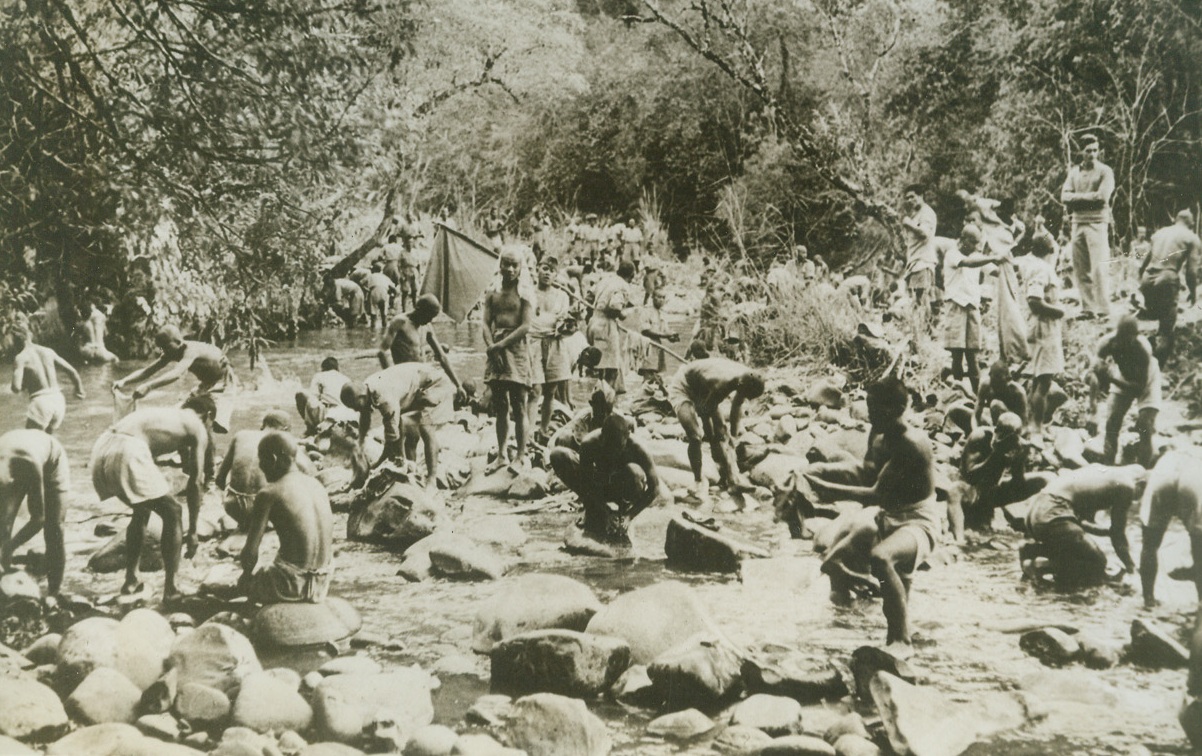
JUNGLE BATH, 5/21/1943. BURMA—Ubduab tribesmen wash the sweat of labor from their bodies and clothing in a rocky jungle stream along the new supply road to Burma. The tribesmen helped Allied troops to cut a supply route through miles of jungle, forests and mountains—which will have to serve the Allies until the Burma road can be reopened. Credit: ACME.;

THE WINDING WAY TO BURMA, 5/21/1943. BURMA—A convoy of jeeps moves slowly along the narrow, winding road to Burma, to carry supplies to Allied troops stationed there. Built by the Army in less than six months, the road is a slender ribbon, twisting through miles of mountains, jungles, and thick forests. In the discussions of long-range Pacific strategy now under way in Washington, Burma is most likely the center of attention, for it is the key to China, through which the attack on the empire of Japan must be made. This small supply route must serve Allied forces until the Japs can be knocked out of Burma and the Burma road reopened. Credit: ACME.;
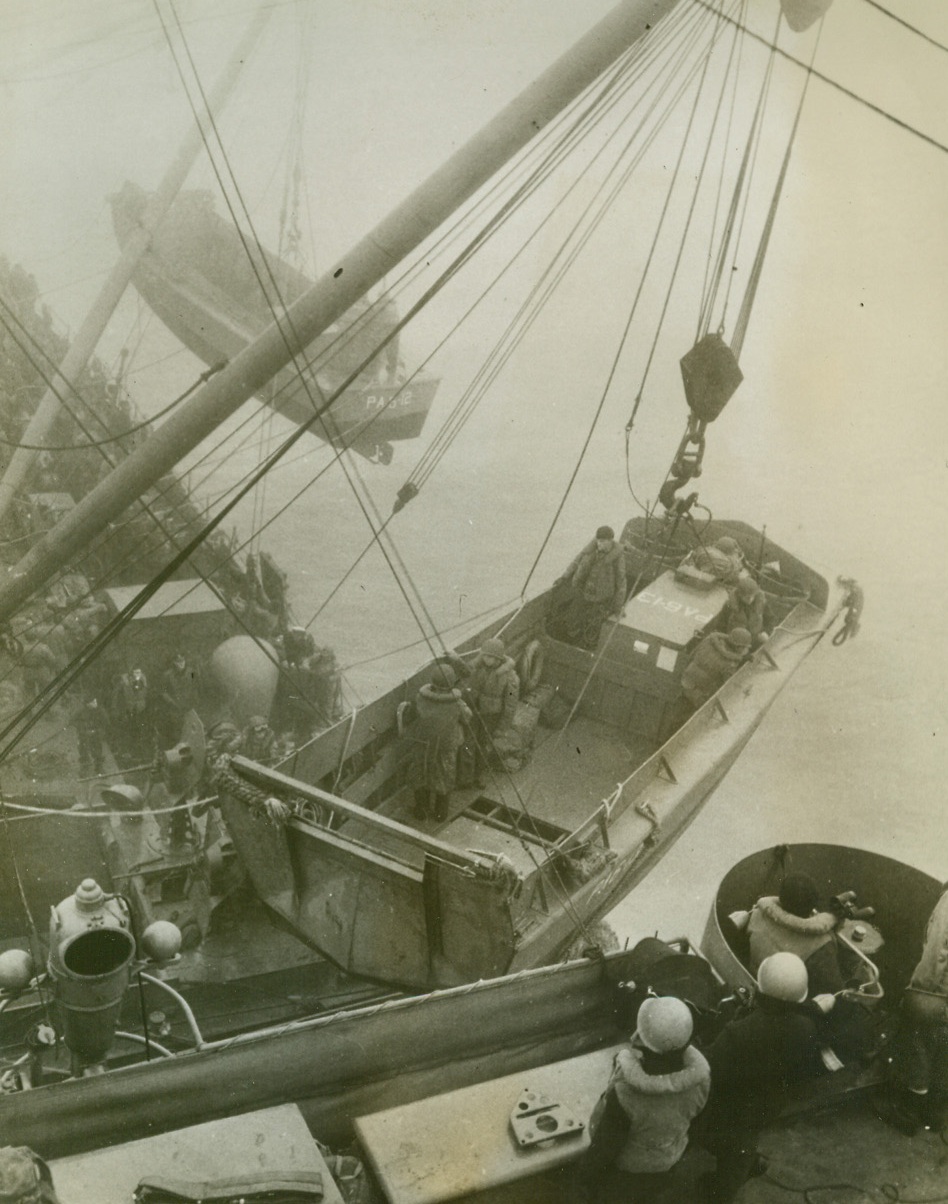
OVER THE SIDE INTO BATTLE, 5/271943. ATTU—Two landing boats are swung aloft from one of the ships that brought American troops to Attu to harass the Japs on that western-most island of the Aleutian chain. Filled with rarin’-to-go fighting men. Boats like these slid onto the shores of Massacre and Holtz Bays on Attu on May 11th, carrying the battle right of the Japs. Fierce hand-to-hand fighting is believed to be taking place on Attu at present, with the American hand uppermost. Credit: ACME.;
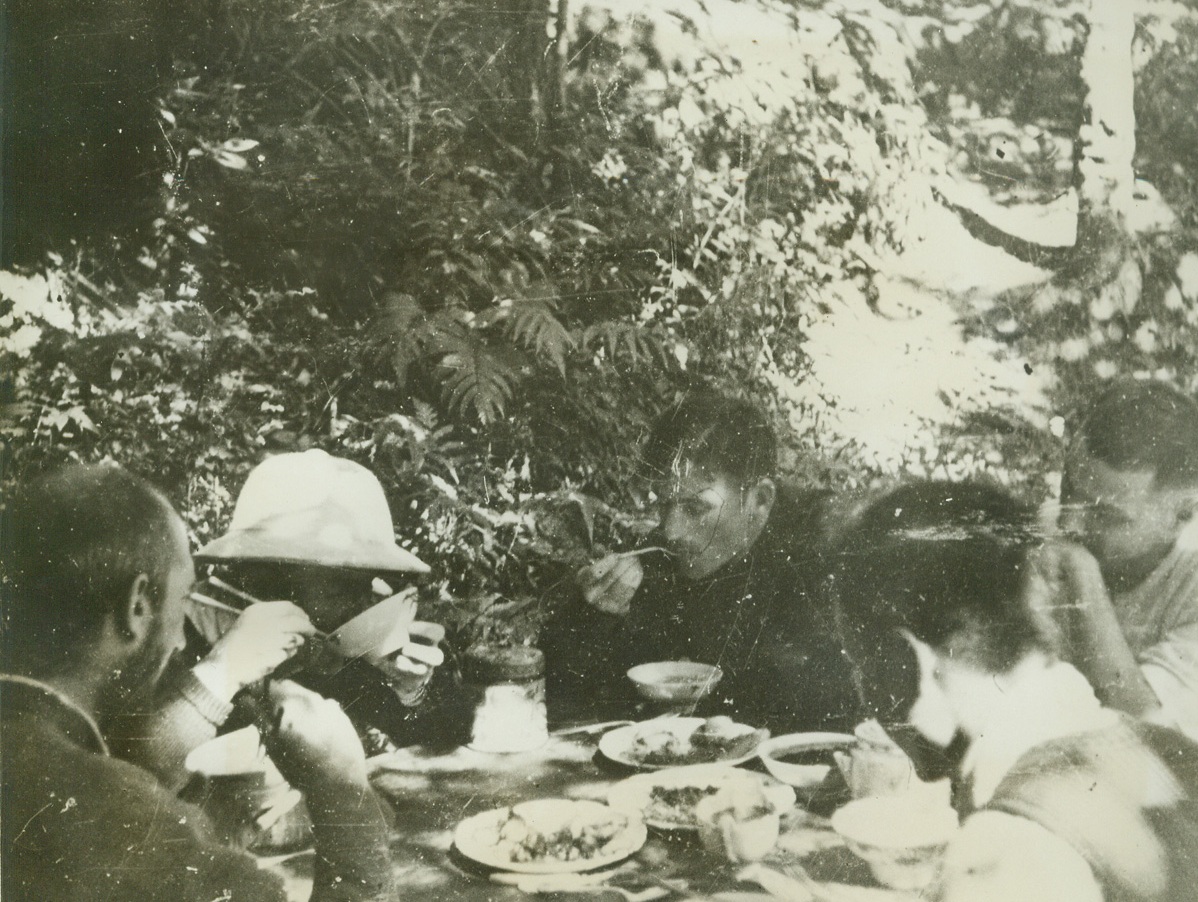
JAP SAVAGERY IN KIANGSI PROVINCE, 5/21/1943. From the camera of Vincentian priests, who served as missionaries in the Chinese Province of Kiangsi in October, 1942, when savage Jap troops visited the countryside to bring death and destruction to tiny towns that gave aid to General Jimmy Doolittle and his men, comes an eloquent record of the sufferings of the Chinese at the hands of brutal, vengeance-seeking Japan. Brought out of China by three priests and five American Sisters of Charity, who hid in the hills while the towns were laid waste, the pictures show violence that far surpasses damage done in modern bombing raids. The Chinese were tortured savagely and put to death en masse. Although the Japs had two objectives-the air field and 200 miles of railroad from Ying-tan to Chin-nua in Chekiang the general conduct of the rail was a punitive one, for it was here that American fliers were fed and treated after their raid of April 18, 1942. Fleeing China after the raid, the eight missionaries traveled on foot, by bus, and finally by boat and plane, reaching the Western Hemisphere five months later. The pictures were obtained in St. Louis from Father Paul Lloyd, director of the Vincentian Foreign Mission Society, and Father George Yager, the Vincentian priest who witnessed the raid and supplied captions for the following photos. Hiding in the hills as the Jap Army of Occupation razes their mission and homes of peasants who remained at home to be tortured and killed. The missionaries eat their meal in the woods. Left to right: Father Tom Smith, Bishop Charles Quinn, Father William Clynn, Father William Stein, and Father Chin. Credit: ACME.;
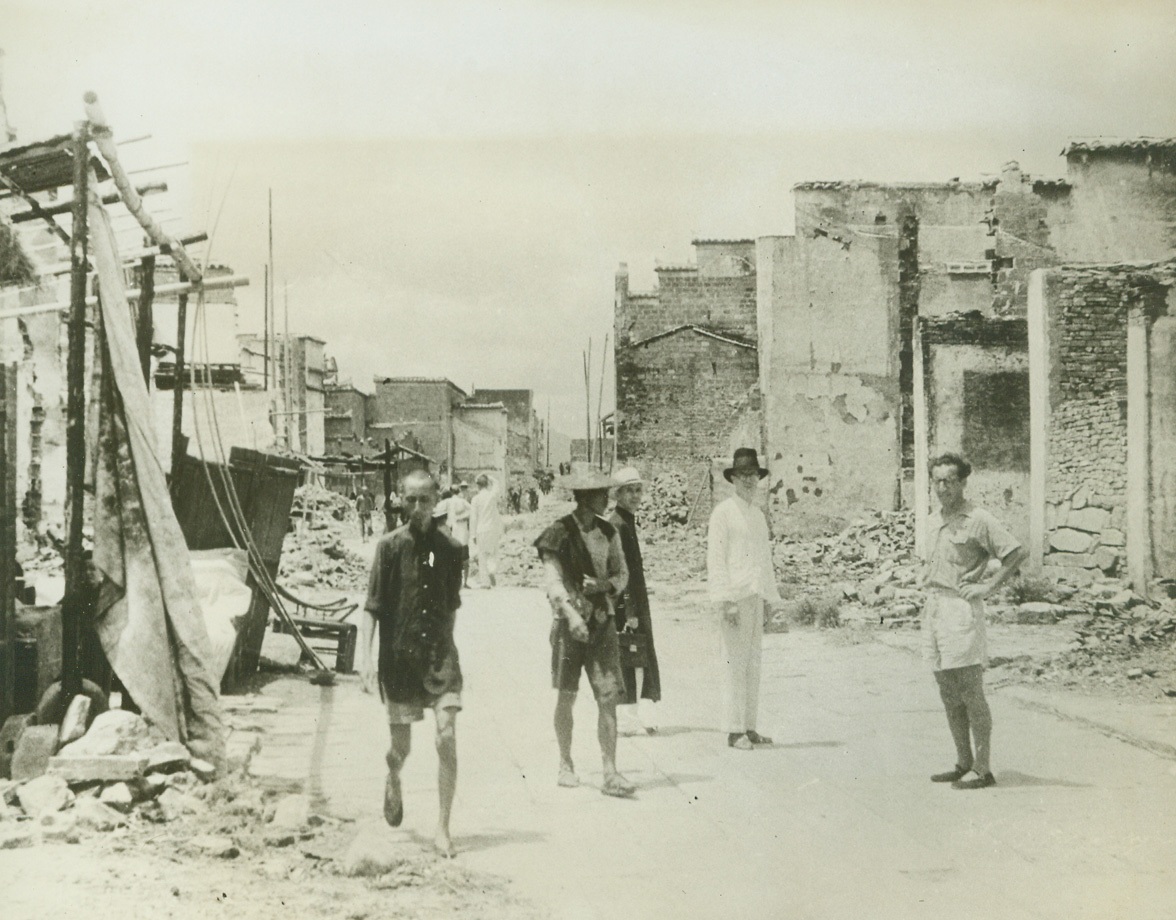
JAP SAVAGERY IN KIANGSI PROVINCE, 5/21/1943. From the camera of Vincentian priests, who served as missionaries in the Chinese Province of Kiangsi in October, 1942, when savage Jap troops visited the countryside to bring death and destruction to tiny towns that gave aid to General Jimmy Doolittle and his men, comes an eloquent record of the sufferings of the Chinese at the hands of brutal, vengeance-seeking Japan. Brought out of China by three priests and five American Sisters of Charity, who hid in the hills while the towns were laid waste, the pictures show violence that far surpasses damage done in modern bombing raids. The Chinese were tortured savagely and put to death en masse. Although the Japs had two objectives-the air field and 200 miles of railroad from Ying-tan to Chin-nua in Chekiang the general conduct of the rail was a punitive one, for it was here that American fliers were fed and treated after their raid of April 18, 1942. Fleeing China after the raid, the eight missionaries traveled on foot, by bus, and finally by boat and plane, reaching the Western Hemisphere five months later. The pictures were obtained in St. Louis from Father Paul Lloyd, director of the Vincentian Foreign Mission Society, and Father George Yager, the Vincentian priest who witnessed the raid and supplied captions for the following photos. Father Frederick Maguire of Philadelphia (third from left) Father Tom McManus of Ireland (center) and an unidentified doctor in Nancheng (not Nanchang) survey the ruins the Japs left behind as they prepare to do relief work. Two Chinese villagers, who were among the few survivors of the vicious raid, walk dejectedly past the wrecked buildings. Credit: ACME.;
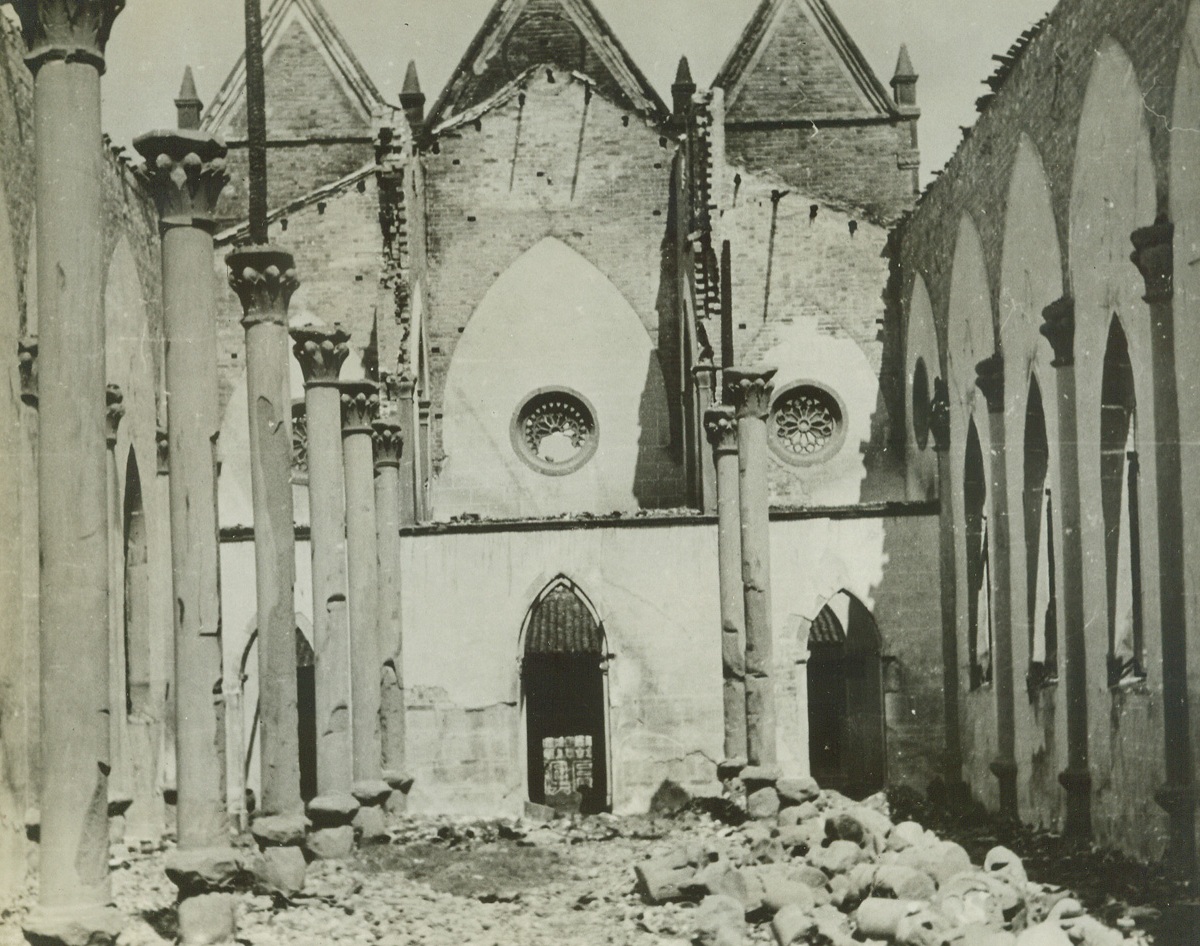
JAP SAVAGERY IN KIANGSI PROVINCE, 5/21/1943. From the camera of Vincentian priests, who served as missionaries in the Chinese Province of Kiangsi in October, 1942, when savage Jap troops visited the countryside to bring death and destruction to tiny towns that gave aid to General Jimmy Doolittle and his men, comes an eloquent record of the sufferings of the Chinese at the hands of brutal, vengeance-seeking Japan. Brought out of China by three priests and five American Sisters of Charity, who hid in the hills while the towns were laid waste, the pictures show violence that far surpasses damage done in modern bombing raids. The Chinese were tortured savagely and put to death en masse. Although the Japs had two objectives-the air field and 200 miles of railroad from Ying-tan to Chin-nua in Chekiang the general conduct of the rail was a punitive one, for it was here that American fliers were fed and treated after their raid of April 18, 1942. Fleeing China after the raid, the eight missionaries traveled on foot, by bus, and finally by boat and plane, reaching the Western Hemisphere five months later. The pictures were obtained in St. Louis from Father Paul Lloyd, director of the Vincentian Foreign Mission Society, and Father George Yager, the Vincentian priest who witnessed the raid and supplied captions for the following photos. Even the Chinese churches failed to escape demolition at the hands of raiding Jap troops. Here is a view of the rear of Ying-tan church after the Japanese laid waste the city. Credit: ACME;

JAP SAVAGERY IN KIANGSI PROVINCE, 5/21/1943. From the camera of Vincentian priests, who served as missionaries in the Chinese Province of Kiangsi in October, 1942, when savage Jap troops visited the countryside to bring death and destruction to tiny towns that gave aid to General Jimmy Doolittle and his men, comes an eloquent record of the sufferings of the Chinese at the hands of brutal, vengeance-seeking Japan. Brought out of China by three priests and five American Sisters of Charity, who hid in the hills while the towns were laid waste, the pictures show violence that far surpasses damage done in modern bombing raids. The Chinese were tortured savagely and put to death en masse. Although the Japs had two objectives-the air field and 200 miles of railroad from Ying-tan to Chin-nua in Chekiang the general conduct of the rail was a punitive one, for it was here that American fliers were fed and treated after their raid of April 18, 1942. Fleeing China after the raid, the eight missionaries traveled on foot, by bus, and finally by boat and plane, reaching the Western Hemisphere five months later. The pictures were obtained in St. Louis from Father Paul Lloyd, director of the Vincentian Foreign Mission Society, and Father George Yager, the Vincentian priest who witnessed the raid and supplied captions for the following photos. Holding their skirts high, American Sisters of Charity splash through a mountain stream as they flee the fast-approaching Jap Army of destruction. The Sisters abandoned their traditional headdress for the flight, to prevent the large, white headpieces from attracting the attention of aircraft. Credit: ACME.;

JAP SAVAGERY IN KIANGSI PROVINCE, 5/21/1943. From the camera of Vincentian priests, who served as missionaries in the Chinese Province of Kiangsi in October, 1942, when savage Jap troops visited the countryside to bring death and destruction to tiny towns that gave aid to General Jimmy Doolittle and his men, comes an eloquent record of the sufferings of the Chinese at the hands of brutal, vengeance-seeking Japan. Brought out of China by three priests and five American Sisters of Charity, who hid in the hills while the towns were laid waste, the pictures show violence that far surpasses damage done in modern bombing raids. The Chinese were tortured savagely and put to death en masse. Although the Japs had two objectives-the air field and 200 miles of railroad from Ying-tan to Chin-nua in Chekiang the general conduct of the rail was a punitive one, for it was here that American fliers were fed and treated after their raid of April 18, 1942. Fleeing China after the raid, the eight missionaries traveled on foot, by bus, and finally by boat and plane, reaching the Western Hemisphere five months later. The pictures were obtained in St. Louis from Father Paul Lloyd, director of the Vincentian Foreign Mission Society, and Father George Yager, the Vincentian priest who witnessed the raid and supplied captions for the following photos. This grass tent was the home of missionaries as they hid in the hills while savage Japs wrought havoc in Kiangsi towns below. Credit: ACME.;

Axis Raid on Jugoslav Partisans, 5/19/1943. Jugoslavia – A German anti-partisan patrol explodes a munition depot after tracking down a partisan supply headquarters somewhere in Jugoslavia. Activities of these patriots have forced Hitler to keep a large contingent of troops in the occupied country. Photo received from a neutral source, was radioed from Stockholm to New York today (May 19). Credit: ACME Radiophoto;
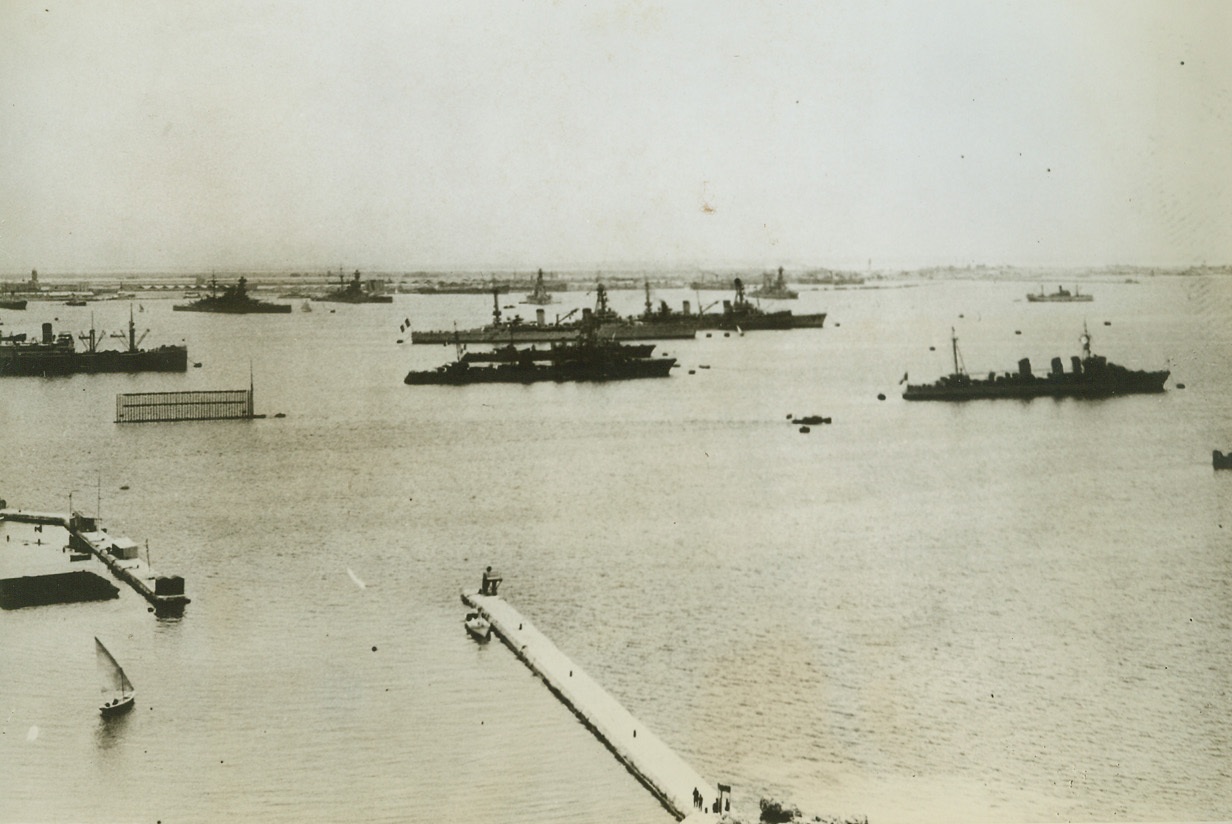
French Egyptian Fleet to Come to New York, 5/31/1943. London – French warships at Alexandria (shown above), which have been lying immobilized since the Fall of France three years ago, have com under the allied control, according to a Berlin radio report last night. The report, not immediately confirmed by any allied source, quoted a Vichy French Government announcement which said that the fleet “had given in to American and British pressure” and that “crewmen said they would join the allies.” One battleship, four cruisers, three destroyers, one submarine and a number of small auxiliary vessels make up the Alexandria fleet.Credit line (ACME);

He Wouldn’t Give Up, 5/19/1943. Tunis: - Soldiers and civilians took part in the street fighting that preceded the fall of Tunis. On the ground is a dead Nazi – he wouldn’t surrender. He kept firing on British soldiers from a garden before meeting an untimely end. Credit line (ACME);
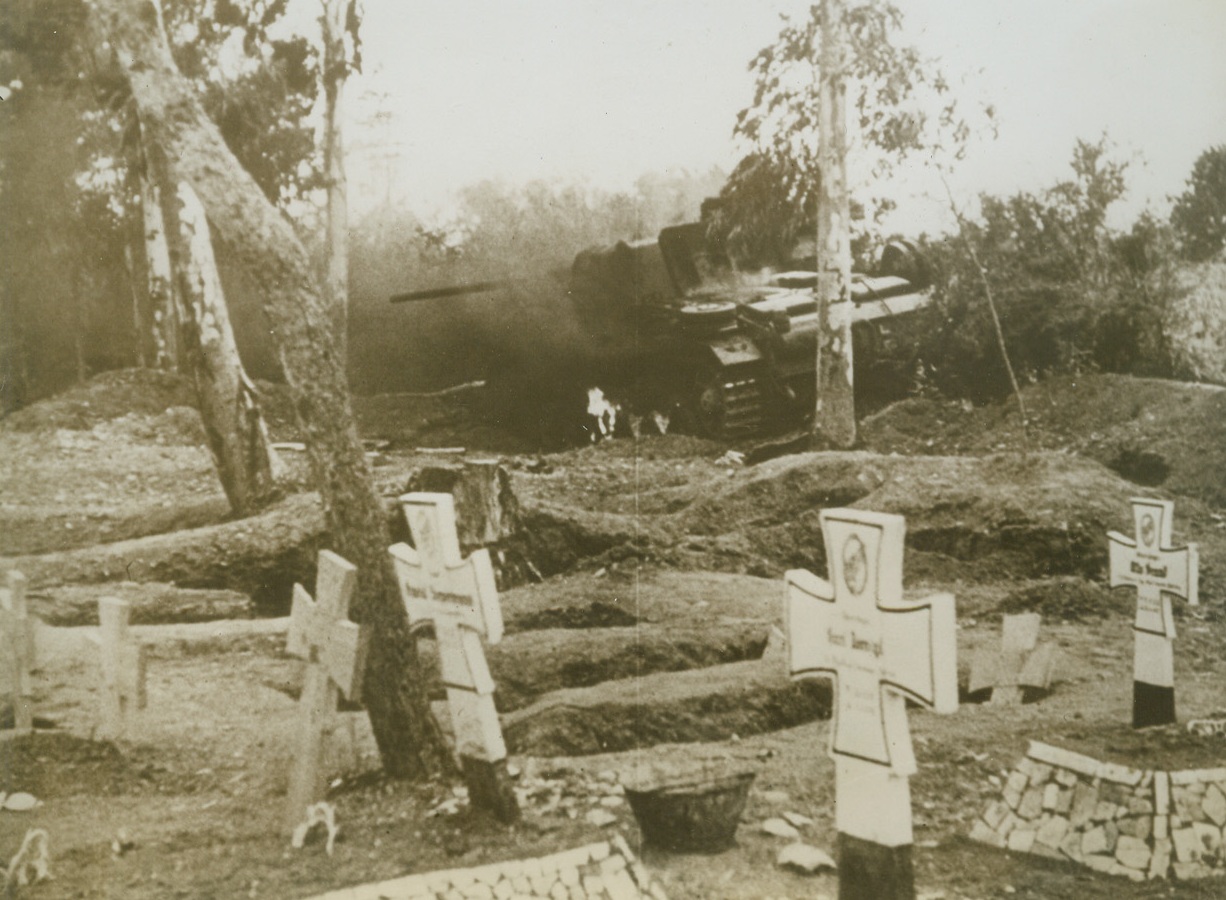
Nazi Tank In Nazi Graveyard, 5/19/1943. Tunisia: - A German tank which met a fate similar to some of the Nazi fighting men. Artillery fire of the British knocked it out of action in the shadow of crosses over graves of Afrika Corpsmen killed in the battle of North Africa. Action took place on the outside of Tunis. Credit Line (ACME);
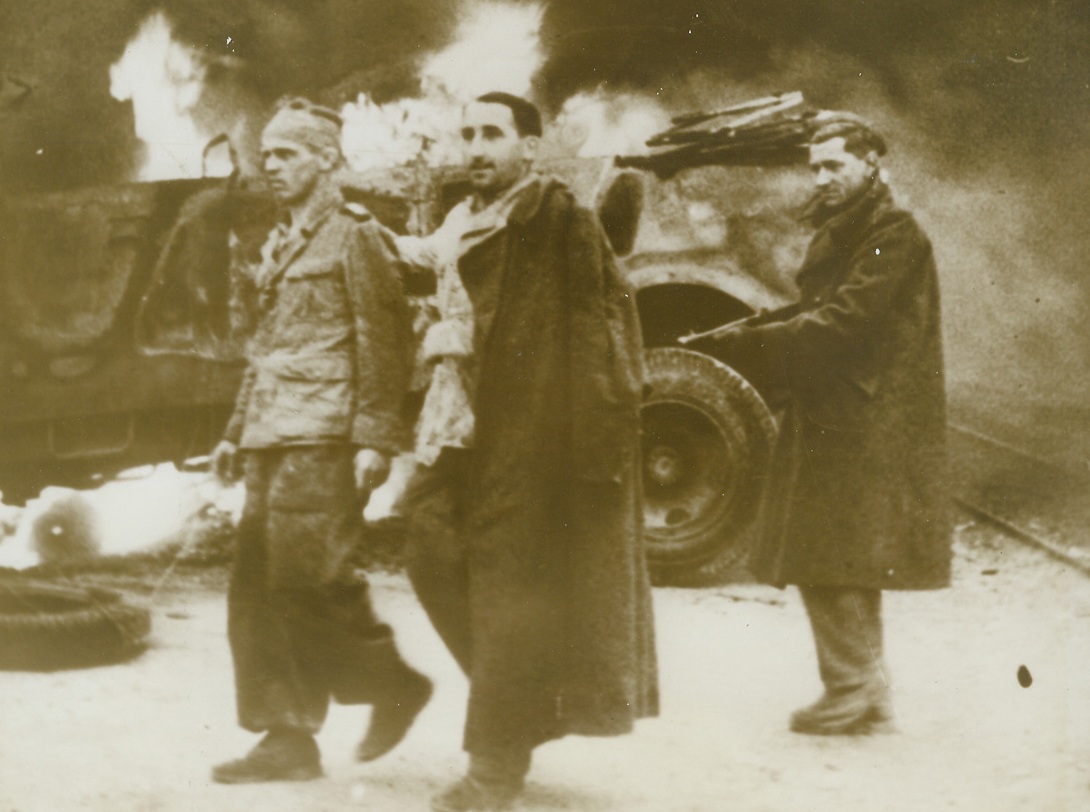
Allies Occupy Tunis, 5/19/1943. Tunis: - A British Tommy keeps his gun pointed at a pair of German prisoners whom he captured when Tunis fell to the allies. The trio march past a Nazi vehicle that is still burning. Credit line (ACME);
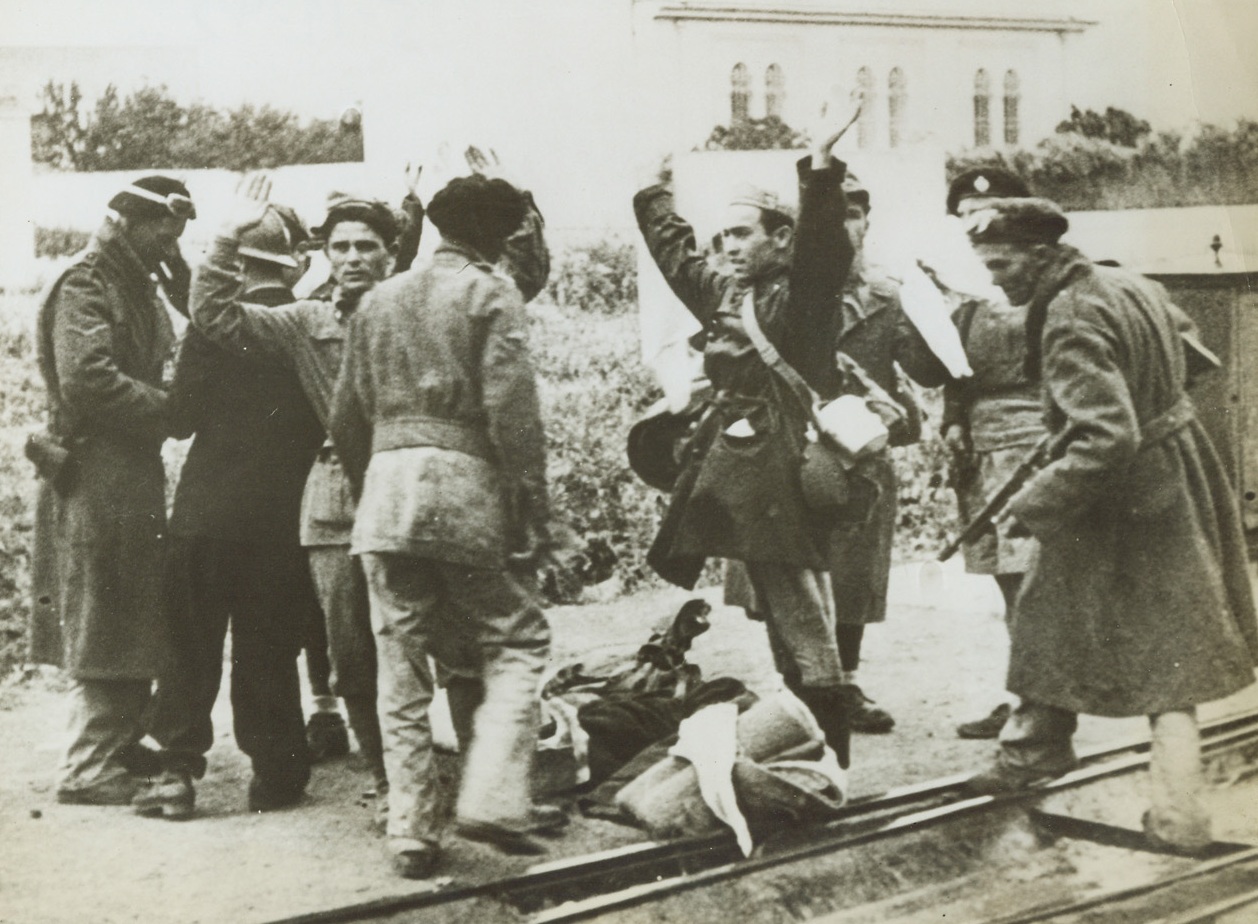
Infiltrators, 5/19/1943. Allied troops capture Nazi spies in Tunis.;
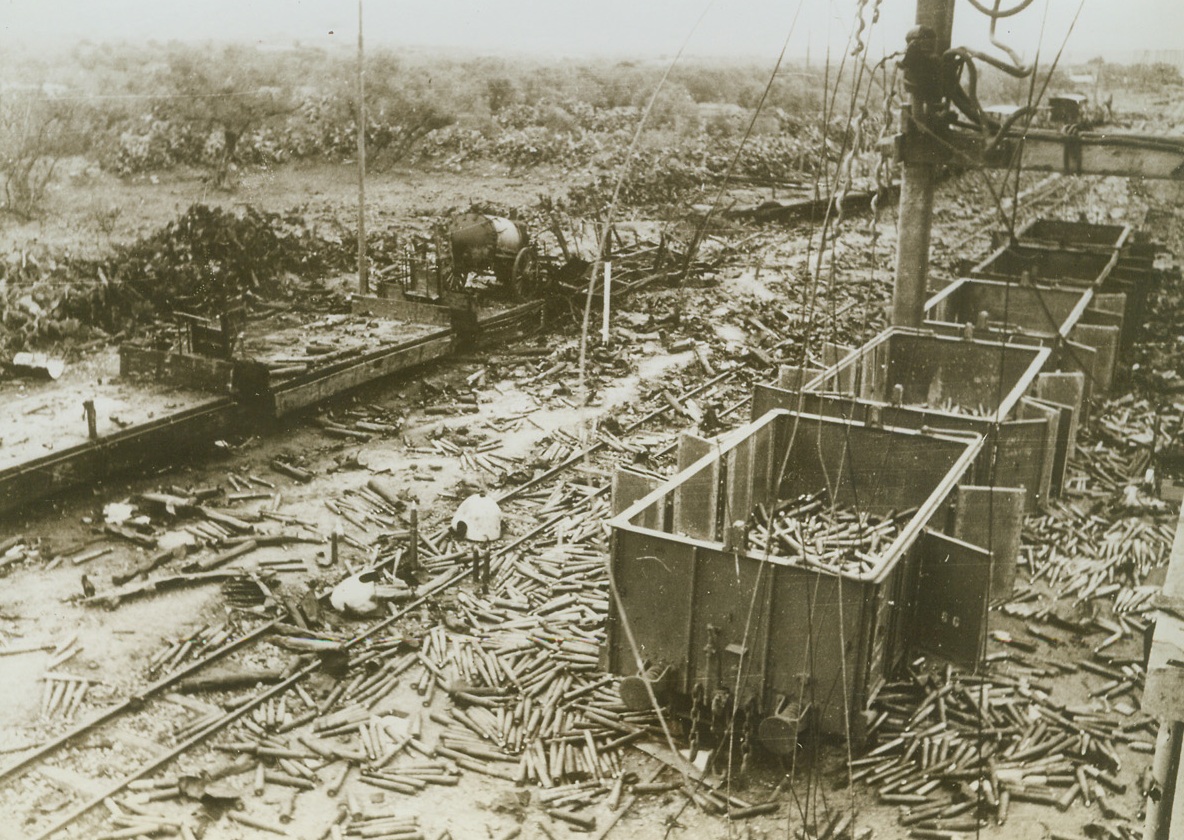
Bullets the Axis Didn’t Use, 5/26/1943. Enfidaville, Tunisia—Scattered beside the wrecked train are shells blown out of a railway car by Allied dive bombers making an attack on Enfidaville during the drive on Tunis. The fury and exactness of Allied air attacks on enemy supplies and communications played a major part in the capture of North Africa from the Axis.Credit: ACME.;
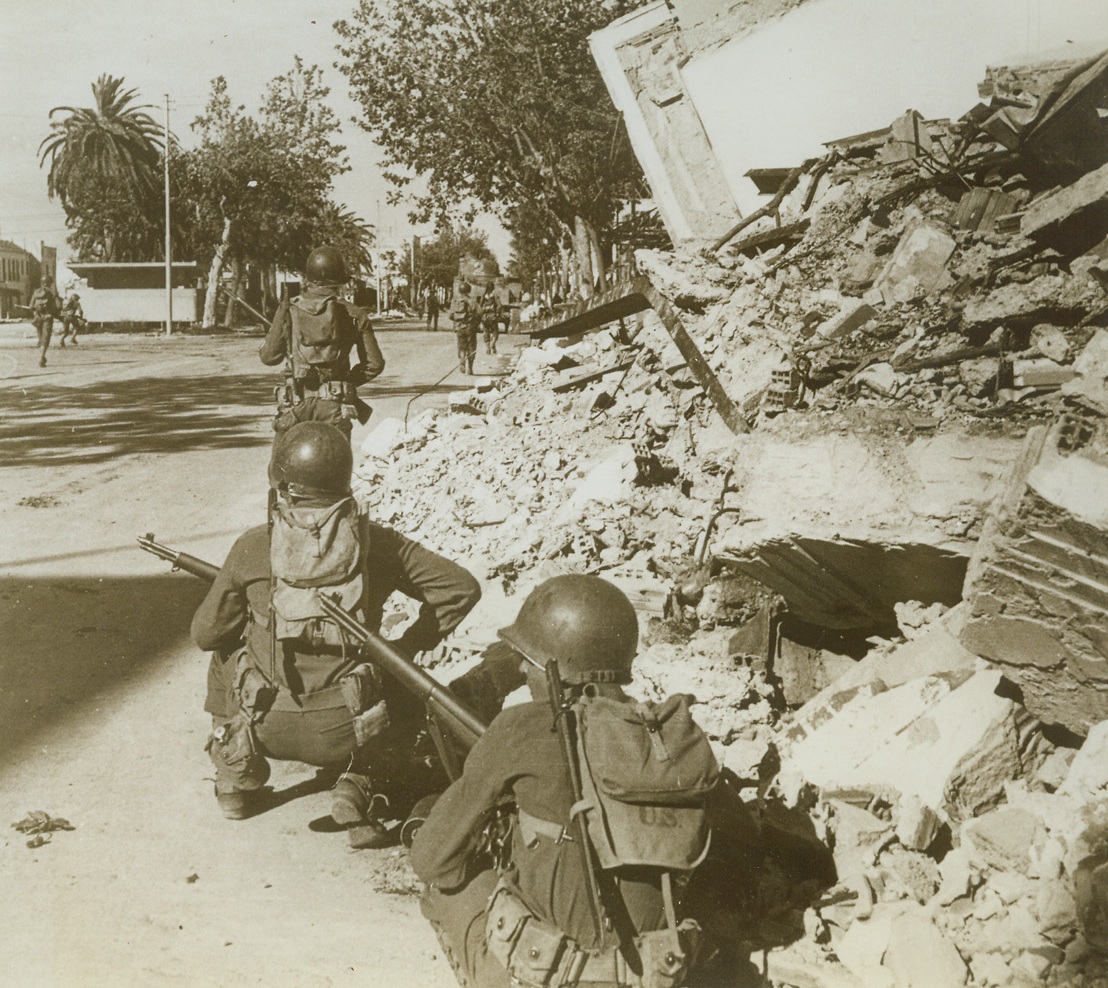
Yanks in Bizerte, 5/26/1943. Bizerte, Tunisia—Crouching beside the ruins of buildings, a U.S. patrol awaits the order to move forward, while another patrol moves forward to reconnotter. Street to street and house to house fighting took place between Allied and Axis troops before Bizerte became Allied property.Credit: ACME.;
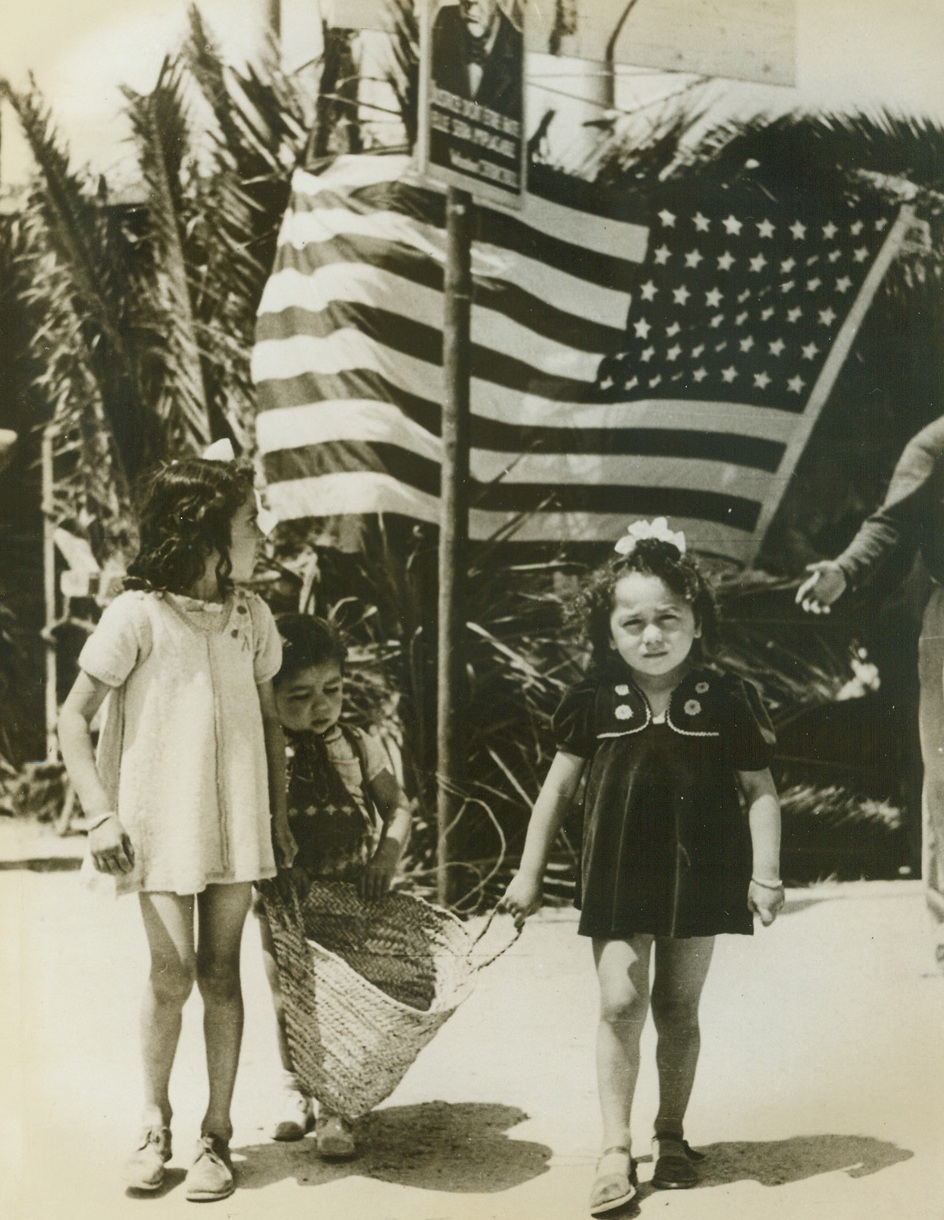
Bringing Home American “Bacon”, 5/21/1943. Tunisia—Three Tunisian youngsters anticipate full tummies as they carry off American foodstuffs distributed at the football stadium in Sousse, Tunisia. A good quantity of the enormous tonnage of U.S. supplies for civilians which has been shipped to North Africa recently has already been distributed to Tunisians, made hungry by the Axis. The shipments consist of goods unobtainable in Tunisia, such as coffee, tea, sugar, biscuits, clothing, and material for making children’s clothes. The people receive ration cards, to be stamped at the time of purchase.Credit: ACME.;

The City Still Stands, 5/22/1943. Tunis—Although Allied bombers pounded heavily at dock installations and military objectives in Tunis while the city was still held by the Axis, the center of the town was left almost intact. Untouched by bombs, this is how Tunis looked from the air soon after American, British, and French troops moved in. Only the trench at bottom right remains as a reminder of warfare that once raged in Tunis.Credit: ACME.;
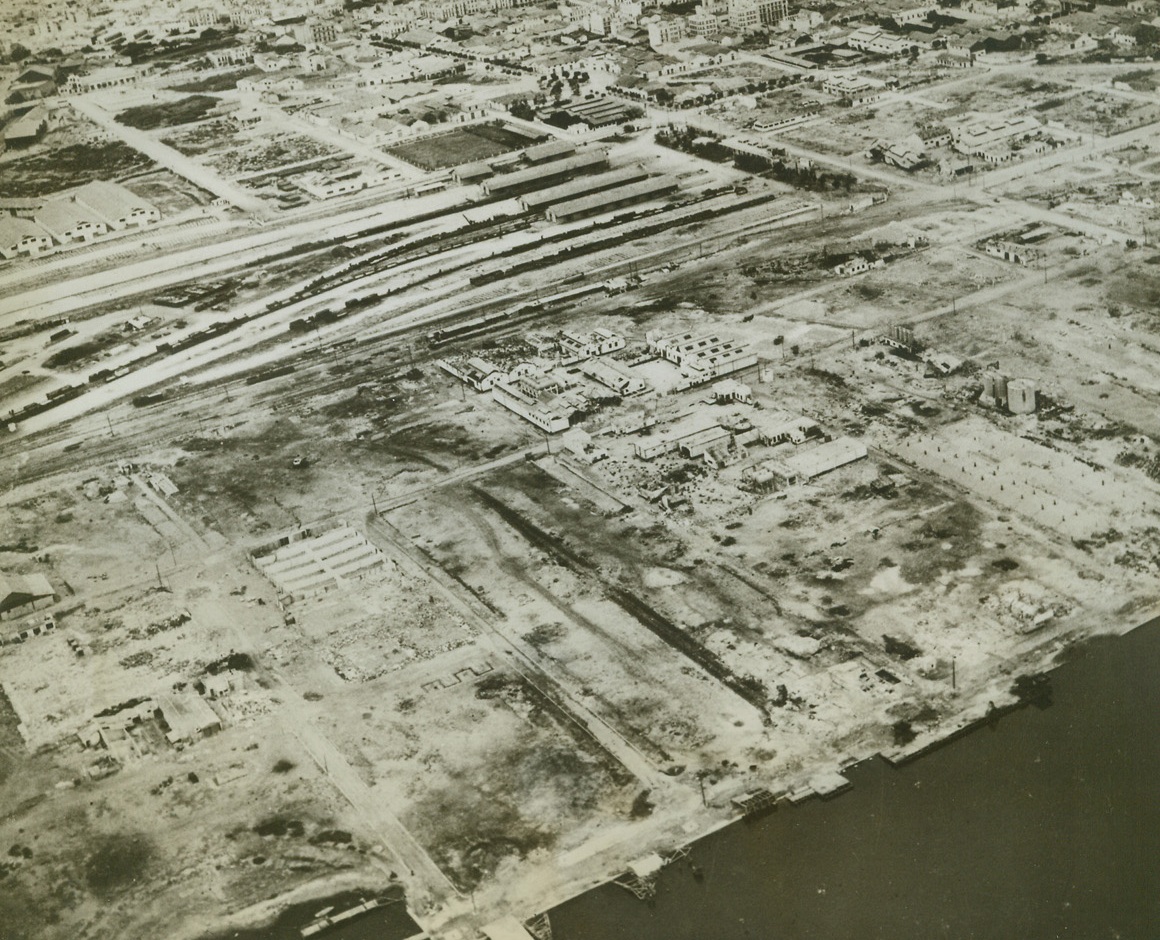
What Allies Did to Tunis, 5/22/1943. Tunis—Acres and acres of bombed docks, with warehouses and installations completely knocked out, are shown in this photo of Tunis, taken by RAF photographers soon after the city was occupied by the Allies. Although the center of the town was left almost intact by raiders, Tunis military objectives took a bad beating from the air.Credit: ACME.;
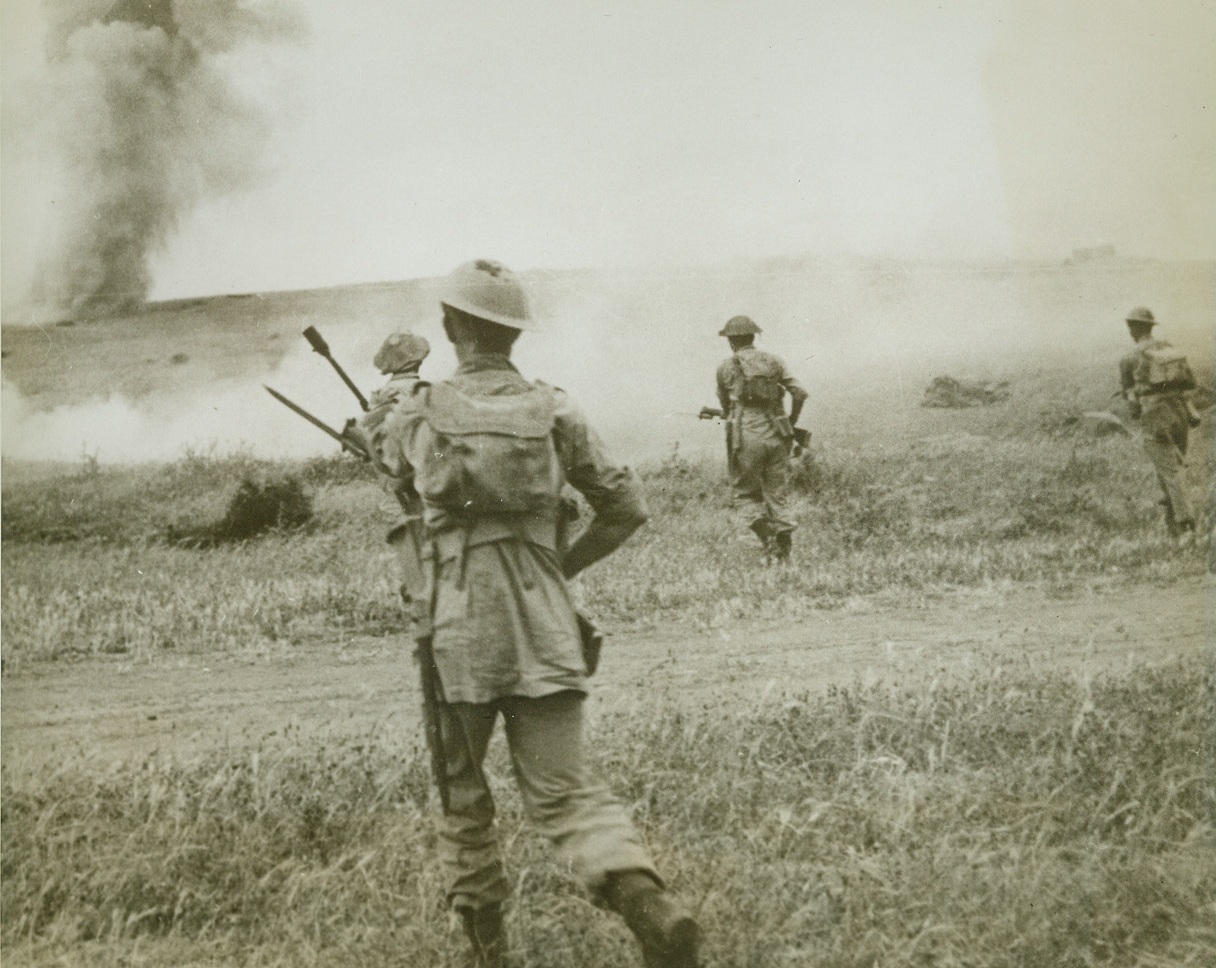
Smashing Through to Tunis, 5/24/1943. Tunisia, N. Africa—The day before the capitulation of Tunis, Eighth Army infantry rush a ridge while under fire from mortars and artillery. After fierce fighting, the British found the fall of the Tunisian capital unexpectedly swift. Credit: ACME.;

...Savagery in Kiangsi Province, 5/25/1943. From the camera of Vincentian priests, who served as missionaries in the Chinese province of Kiangsi in October, 1942, when savage Jap troops visited the countryside to bring death and destruction to tiny towns that gave aid to General Jimmy Doolittle and his men, comes an eloquent record of the suffering of the Chinese at the hands of brutal, vengeance-seeking Japan. Brought out of China by three priests and five American sisters of charity, who hid in the hills while the towns were laid waste, the pictures show violence that far surpasses damage done in modern bombing raids. The Chinese were tortured savagely and put to death en masse. Although the Japs had two objectives - the air field and 200 miles of railroad from Ying-Tan to Chin-Hua in Chekiang - the general conduct of the raid was a punitive one, for it was here that American fliers were fed and treated after their raid of April 18, 1942. Fleeing China after the raid, the eight missionaries traveled on foot, by bus, and finally by boat and plane, reaching the western hemisphere five months later. The pictures were obtained in St. Louis from Father Paul Lloyd, director of the Vincentian Foreign Mission Society, and Father George Yager, the Vincentian priest who witnessed the raid and supplied captions for the following photos. ... Not bombed, but burned and torn down by Japanese Infantry, the city of Ying-Tan lays in ruins. A line of Chinese peasants moves slowly between the rows of wrecked buildings as relief work is begun after the raid.;
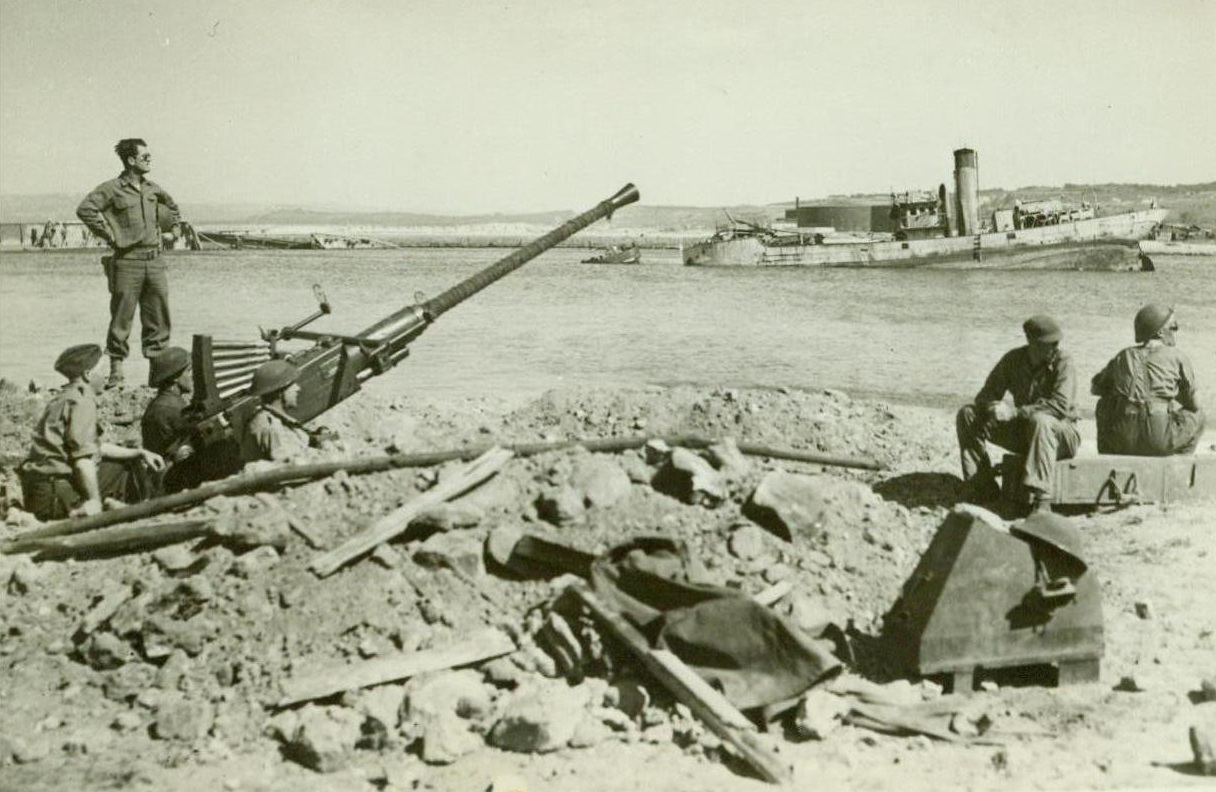
On the Alert in Bizerte, 5/24/1943. BIZERTE, TUNISIA - As the Germans were...swept from Tunisia, the crew of a United...anti-aircraft gun maintain watch for...planes from a foxhole emplacement at...The hulk of a ship resting on bottom...harbor can be seen in the background...;
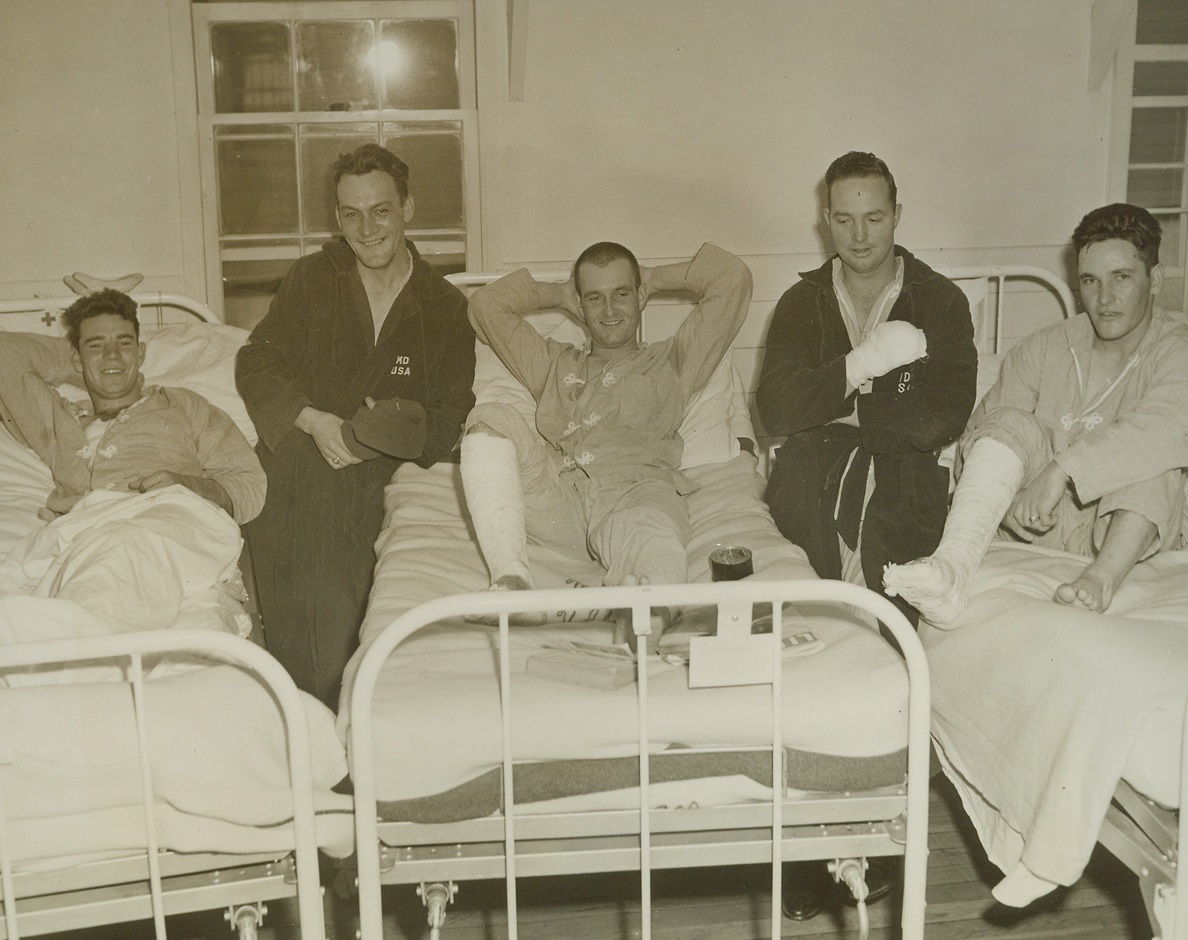
Back Ahead of Schedule, 5/30/1943, Seattle, Washington -- These boys fought on Attu, but their wounds brought them back to the states before the death knell for Jap forces there had been sounded. Recuperating at an army hospital and impatient for the day when they’ll get another crack at the Nip are: (left to right) Pvt. John E. Terknett of Eastland, Texas; Pvt. Joseph E. Kenski of Detroit, Michigan; Pvt. James A. Meredity of Springfield, Illinois; Pvt. Woodrow W. French of Greenwood, Mississippi; and Sgt. Forrest W. Johnson of Flatriver, Missouri. Passed by censor. Credit: ACME;
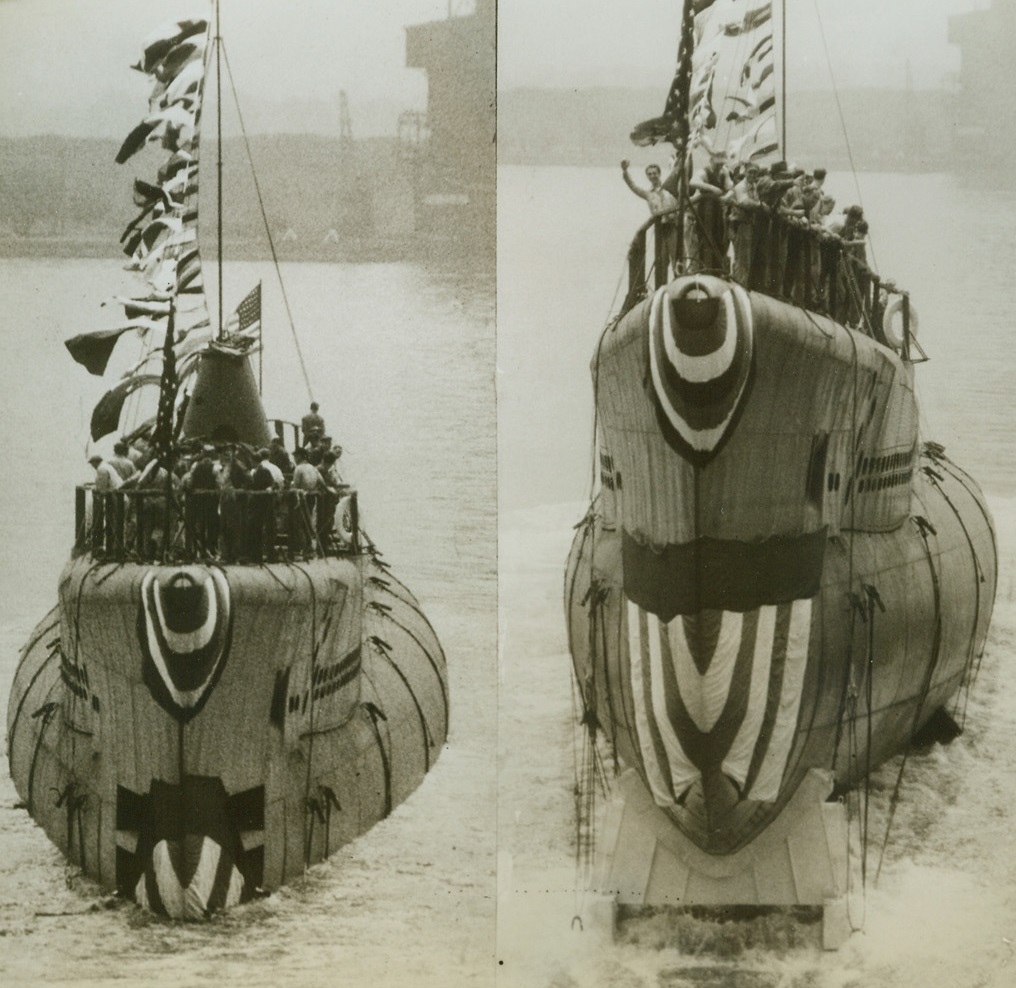
Two More Subs to Sink the Axis, 5/30/1943. Philadelphia, Pennsylvania -- Two more undersea fighters went out to beat Axis U-Boats at their own deadly game when the U.S.S. Devilfish (left) and the U.S.S. Hackleback slid down the ways at Cramp Shipyards today. The Devilfish was christened by Mrs. Frank W. Fenno of Williamsport, wife of a Navy Cross winner. Mrs. William L. Wright of Corpus Christi, Texas, whose husband was decorated for the sinking of three Jap warships and five Merchantmen, sponsored the Hackleback. Credit: ACME;

First Photos of Yank Landing on Attu, 5/26/1943. Washington, D.C. -- This photo, one of the first taken of the landing of U.S. troops on Jap-held Attu Island last May 11, was taken by a Navy combat photographer and released in Washington today. Cameramen who took these photos of the landing at two points on the island, Massacre Bay and Holtz Bay, were under Jap fire many times. Here, heavily laden landing boats, with soldiers crouching down out of line of sniper fire, approach the west arm of Holtz Bay. Passed by censor. Credit: U.S. Navy photo from ACME;
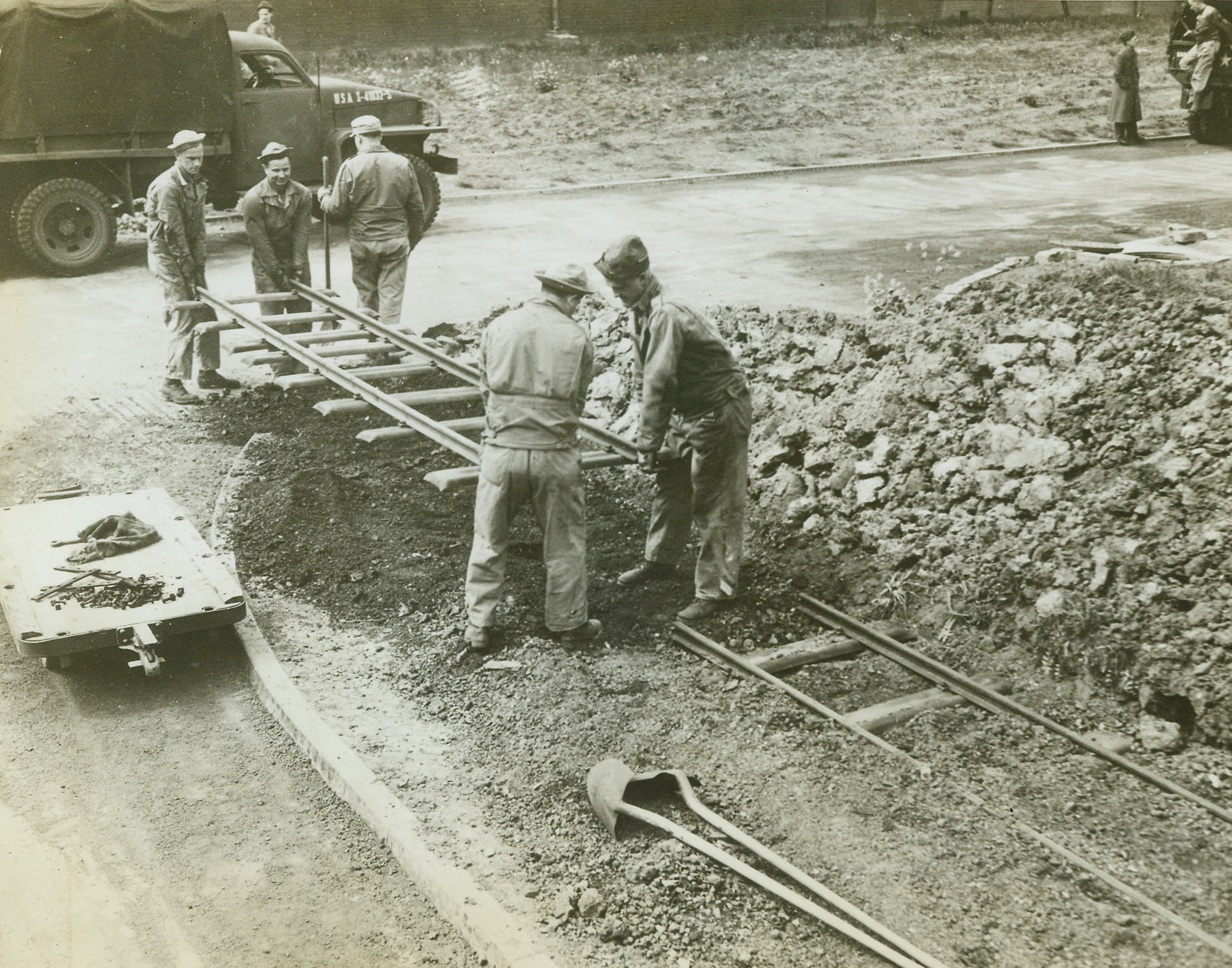
The Last Track, 5/22/1943. Somewhere in England -- American Army engineers lay the last bit of track for the 17-mile, narrow gauge railroad, built and operated by U.S. forces at an Army Supply Depot in England. The road was build to haul supplies between Army warehouses and unloading and shipping points in Britain. Credit: ACME;
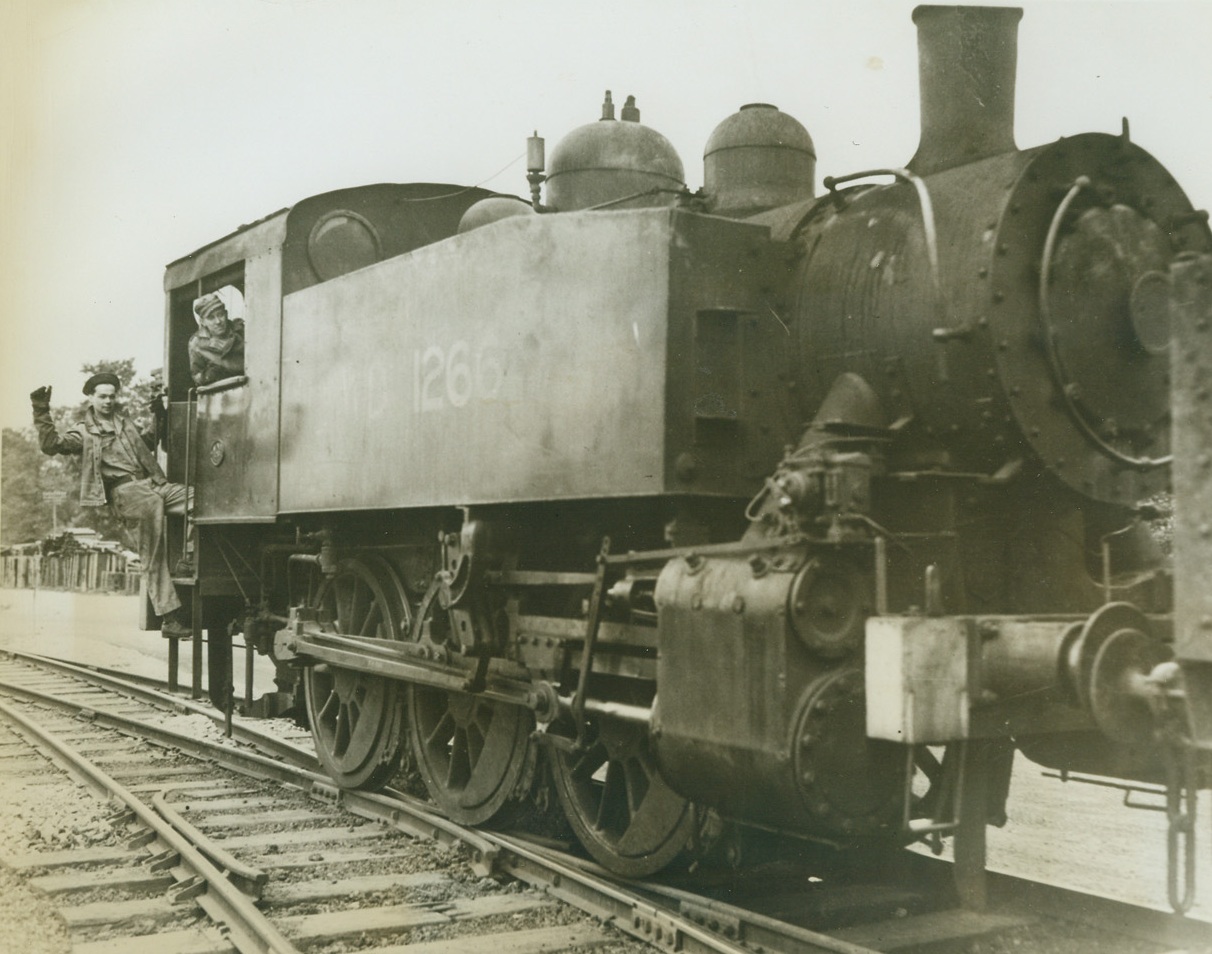
Rolling Along, 5/22/1943. Somewhere in England -- Rolling along the only American-built-and-operated railroad in England, this engine hauls Army supplies to and from Army warehouses. The 17-mile, narrow gauge railroad was built by U.S. Army engineers to facilitate transportation of equipment. Credit: ACME;
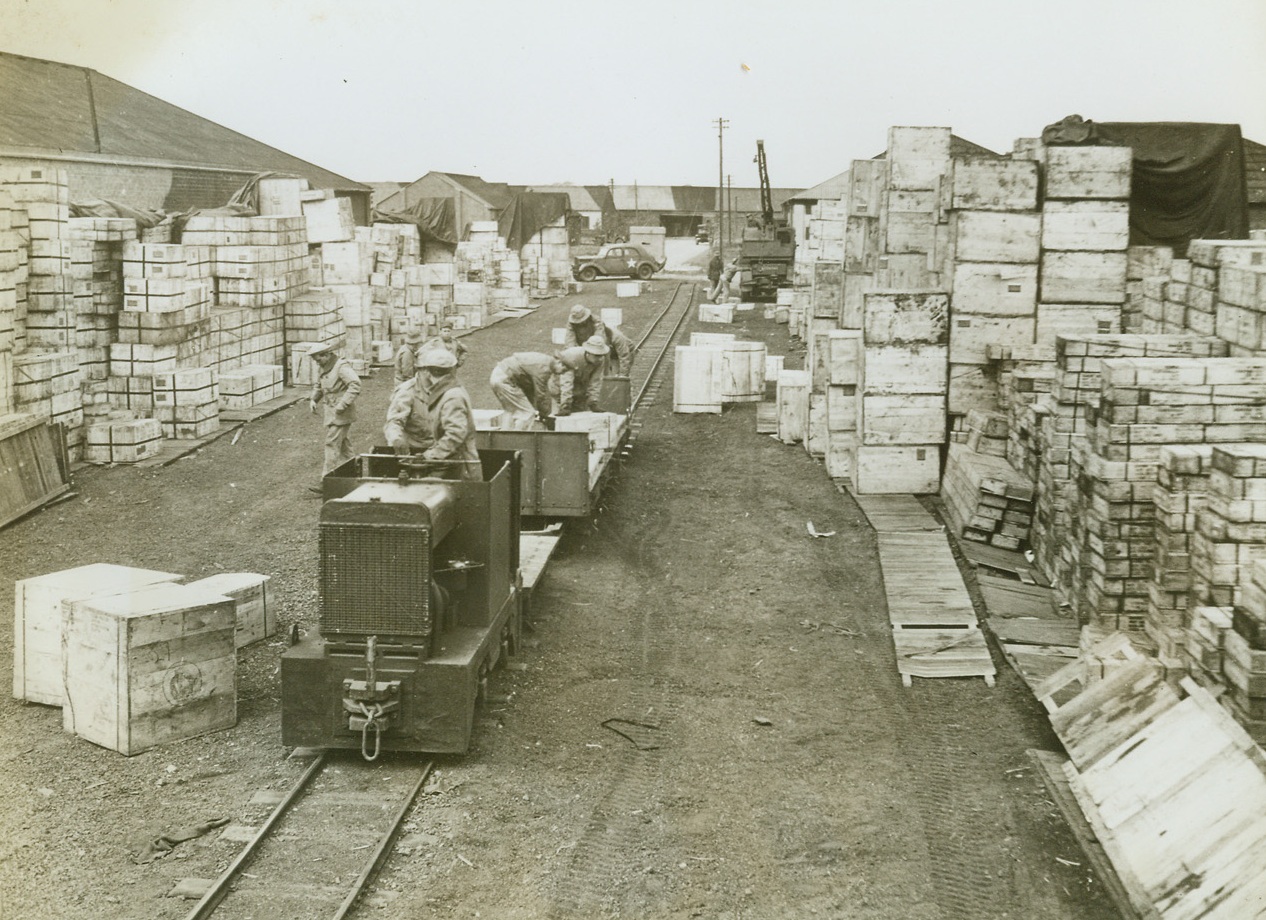
American Railroad in England, 5/22/1943. Somewhere in England -- American soldiers stack crates of supplies on a car that runs along the only U.S.-built and operated railroad in England. Covering 17 miles of trackage, the railroad was built by the Army to haul supplies from the British unloading point to the warehouses, or from U.S. warehouses to British lines for shipment. Credit: ACME;
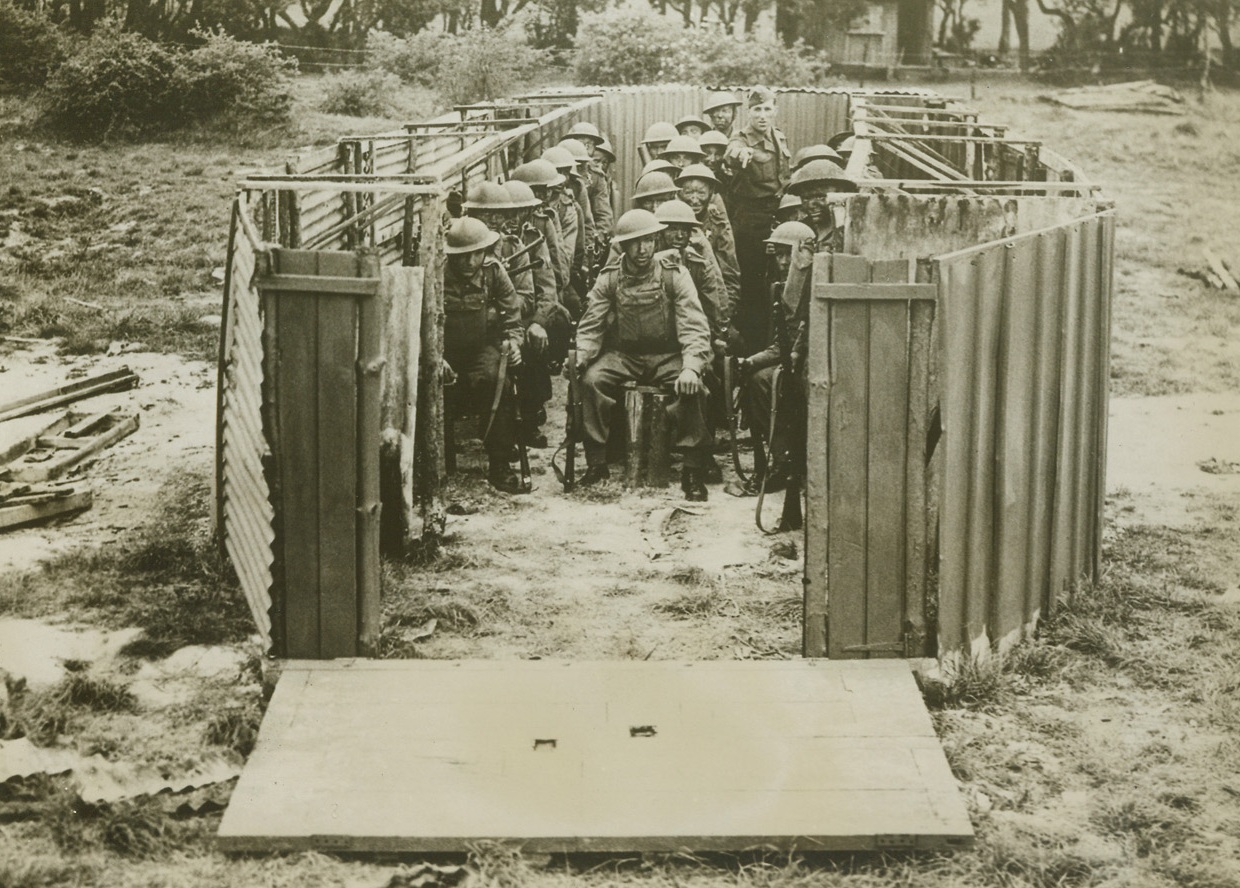
DRY LANDING, 5/24/1943. SOMEWHERE IN ENGLAND – All set for invasion and no place to invade is the predicament of these royal Marines who are ready to pile out of a landing barge built on dry land. With their faces blackened, they receive instructions from an officer on the “invasion” craft in Southern England. These fighters, undergoing the toughest of training, hope to be the first Allied troops to set foot on the European continent. Credit: Acme;
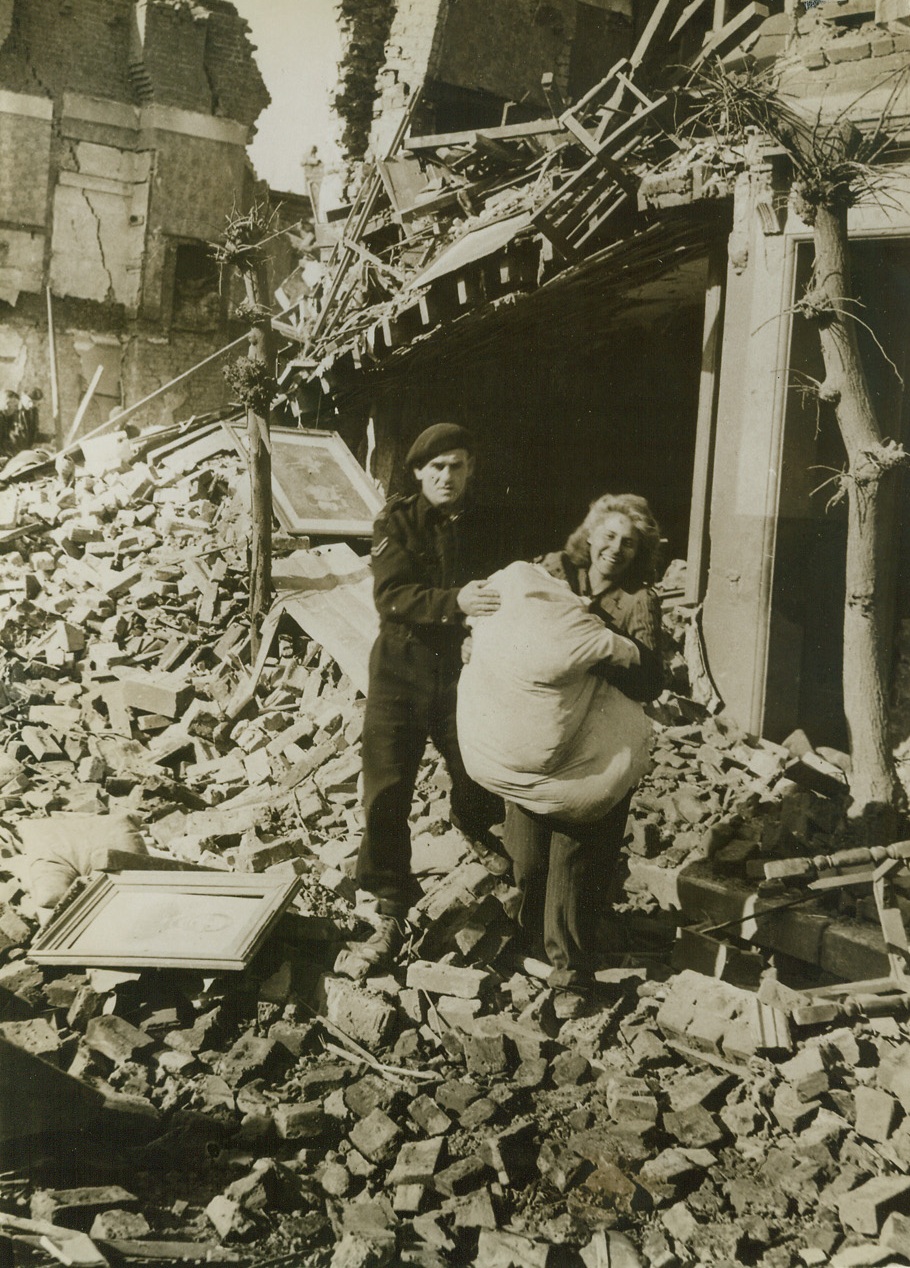
Smilin’ Thru, 5/23/1943. London, England - Smiling cheerfully as she salvages her belongings from a bomb-wrecked home, this woman is typical of the average Briton. Not even nuisance raids by enemy bombers can shake British confidence in eventual Allied victory. With all Africa conquered and Nazi Europe trembling before the threat of Allied invasion, she knows that it’s only a matter of time ‘till the Axis surrenders - unconditionally. The German Air Force flew over England again, tonight (May 23), in more that a “nuisance” raid. Bombing and strafing two coastal resort towns, Nazi bombers carried out one of the worst raids since the Battle of Britain. Credit: ACME;
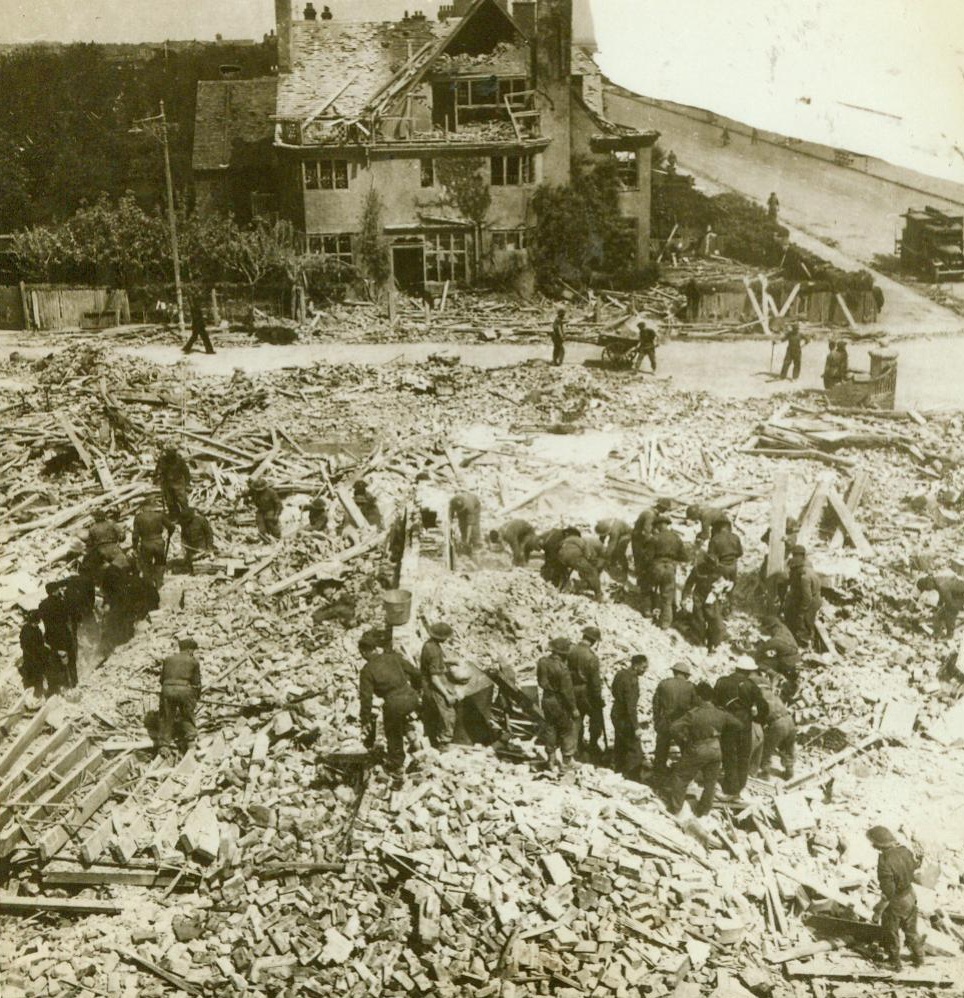
Another Nazi “Military” Target, 5/21/1943. England -- British soldiers dig in the wreckage of the Auxiliary Territorial Service Building where at least twelve girls of the organization met death when a Focke-Wulf Fighter-Bomber scored a direct hit on the hostel. Fifteen enemy planes took part in the raid on the East England coast town, bombing and machine-gunning the streets from rooftop level. There was also extensive damage done to houses. Credit: ACME;
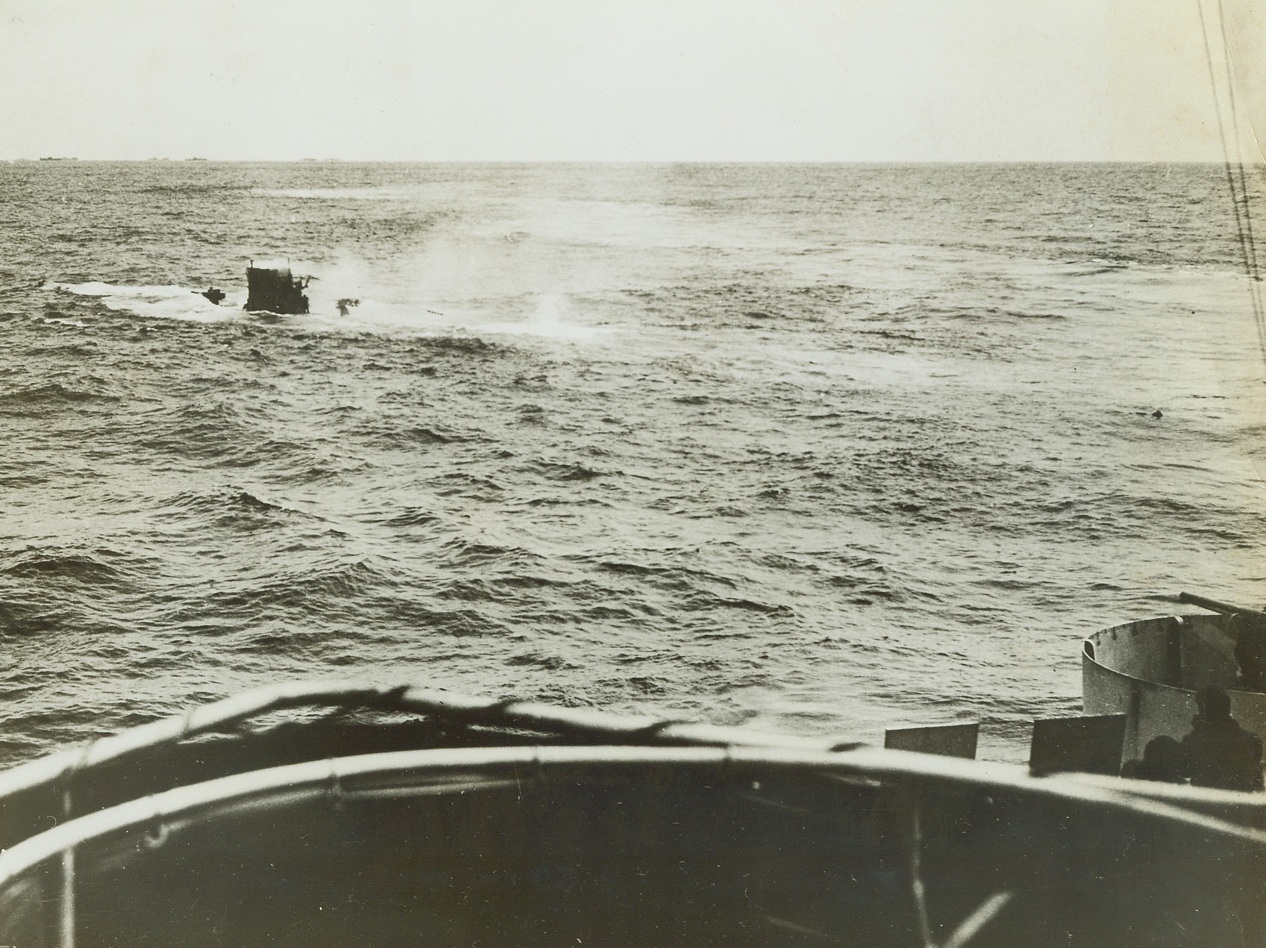
Coast Guard Cutter Sinks Submarine, 5/31/1943. A German submarine attempted to sneak in between a convoy of ships crossing the North Atlantic. Coast Guard Cutters escorting the Merchantmen sighted the U-Boat and The Spencer went into action, aided by The Duane. The Spencer let go a depth charge which brought the sub to the surface; and, then as water rushed into her crushed hull she sank as the Coast Guard picked up her survivors. Bearing down on the sub, The Spencer gets a good look at the sinking sub as she settles in the water. Note the Nazi standing on the deck to the right of the conning tower, and at the right, The Spencer’s gun trained on the U-Boat. A swimming German is barely discernable in the water on the right. Credit: U.S. Coast Guard photo from ACME;
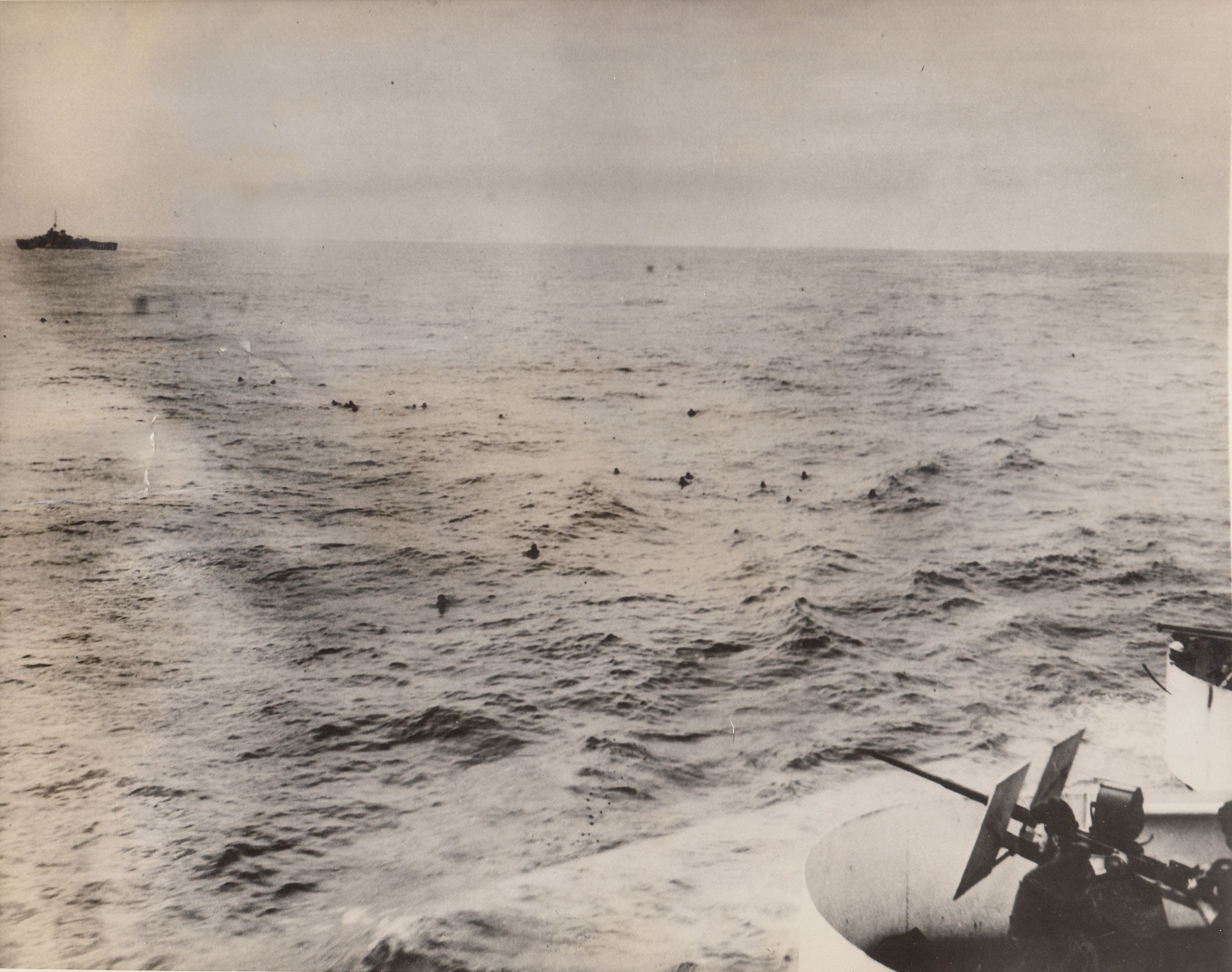
Subless Supermen, 5/31/1943. North Atlantic – “Oh where, oh where has that submarine gone” is the song of these Nazis as they paddle for their lives toward the U.S. Coast Guard cutter Spencer, which forced up and sank their undersea craft in a recent North Atlantic action. The U.S. Coast Guard Cutter Duane, which aided in the rescue, is shown in the background. The enemy sub was trying to sneak into the midst of a big convoy when the Spencer (right foreground) sent it to Davy Jones.;

After Our Bombers Left, 5/20/1943. Antwerp—Rushing from their shelters as the “all clear” sounds, civilians throng in the streets of Antwerp to survey the damage done by American bombers in their devastating daylight raid. Photo was recently received in England through a neutral source. 3/20/43 (ACME;





 Trash & Recycling
Trash & Recycling
 Online Payments
Online Payments
 City Documents
City Documents
 Parks
Parks
 Traffic Court
Traffic Court
 City Parks
City Parks
 Outdoor Recreation
Outdoor Recreation
 Volunteer
Volunteer
 Home
Home TRANSLATE
TRANSLATE
